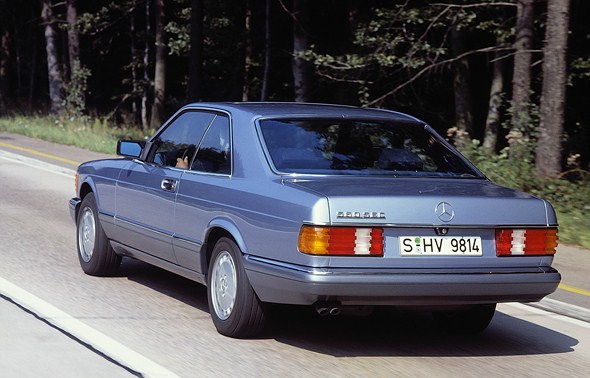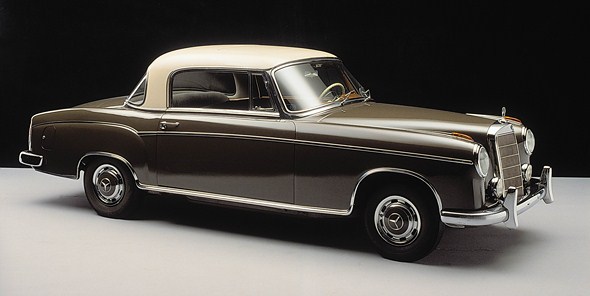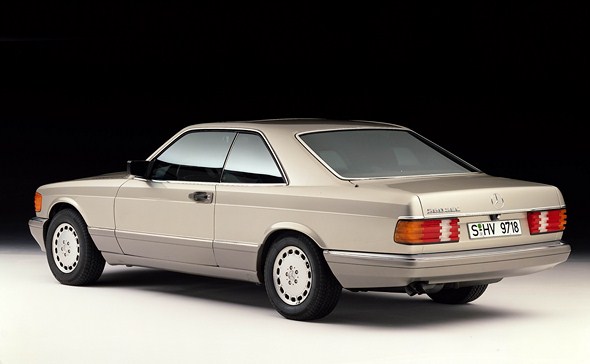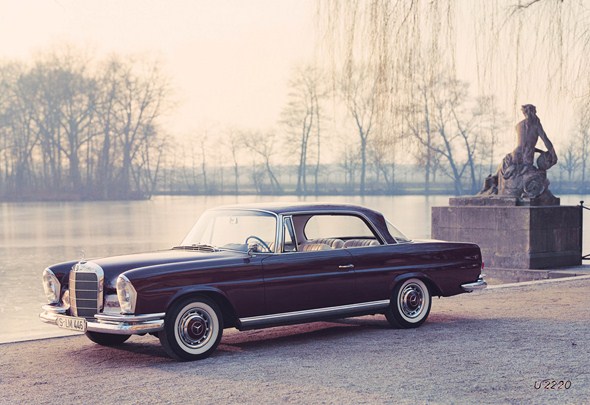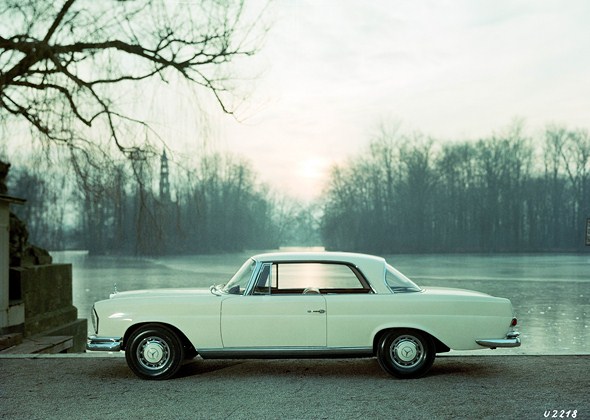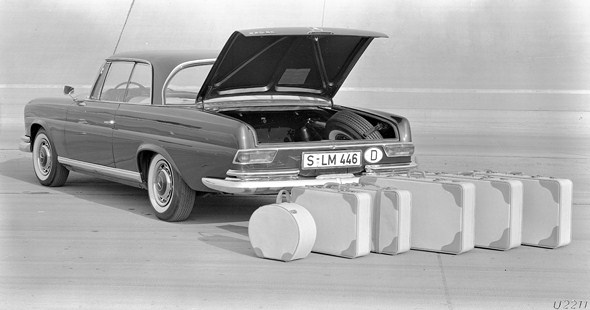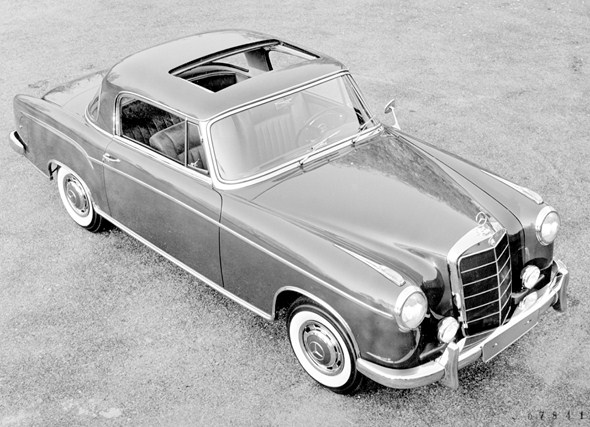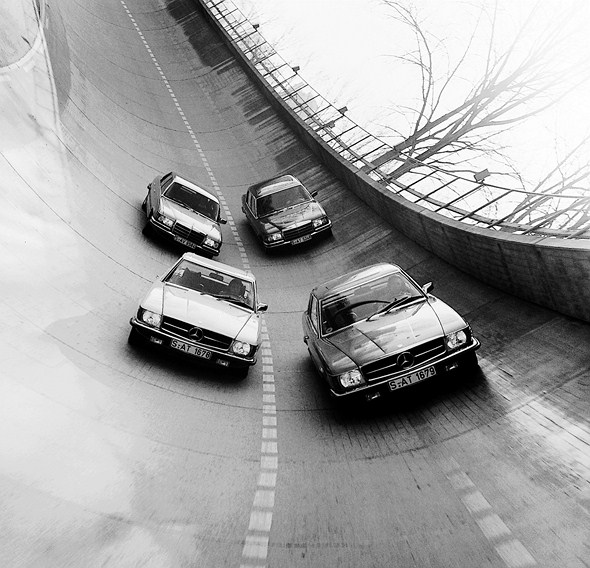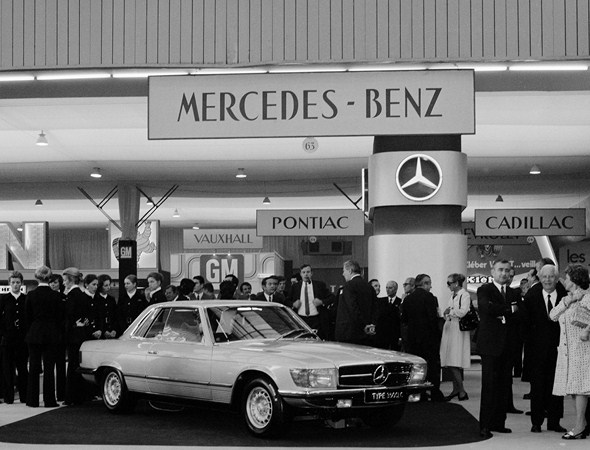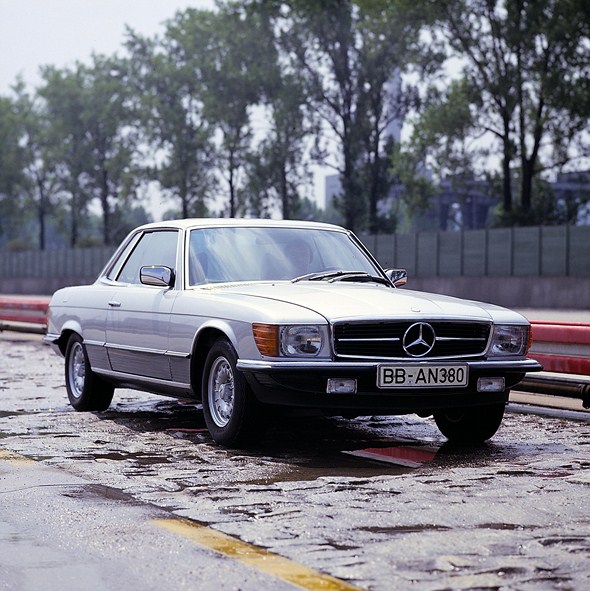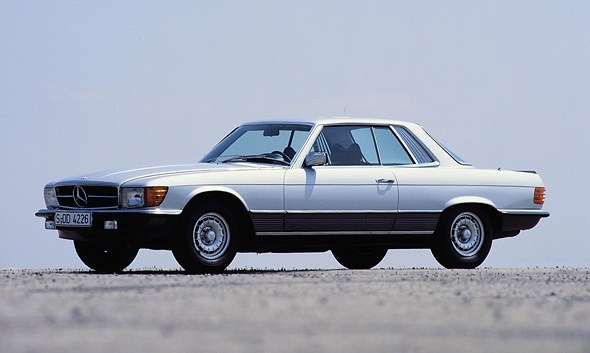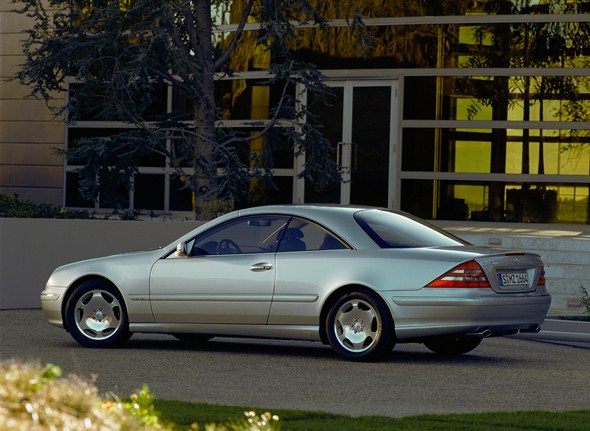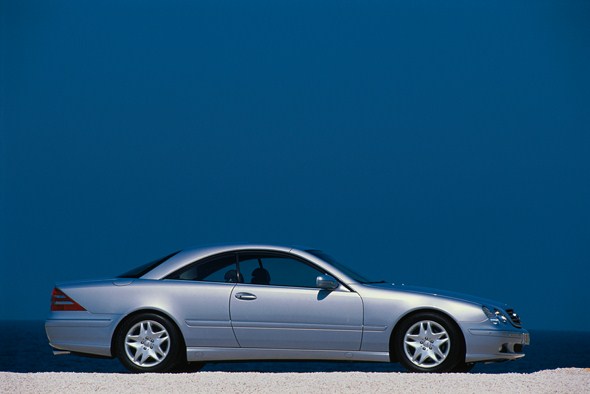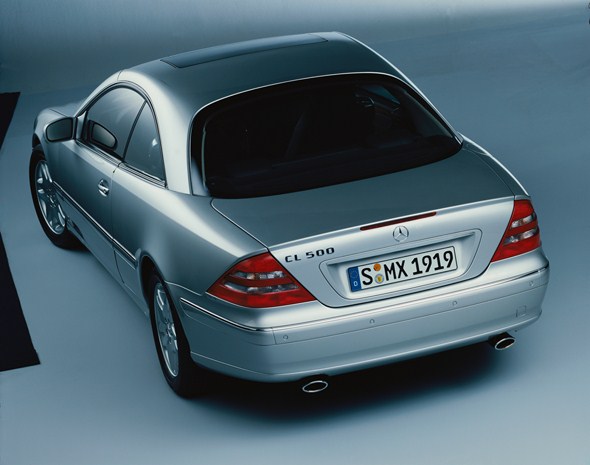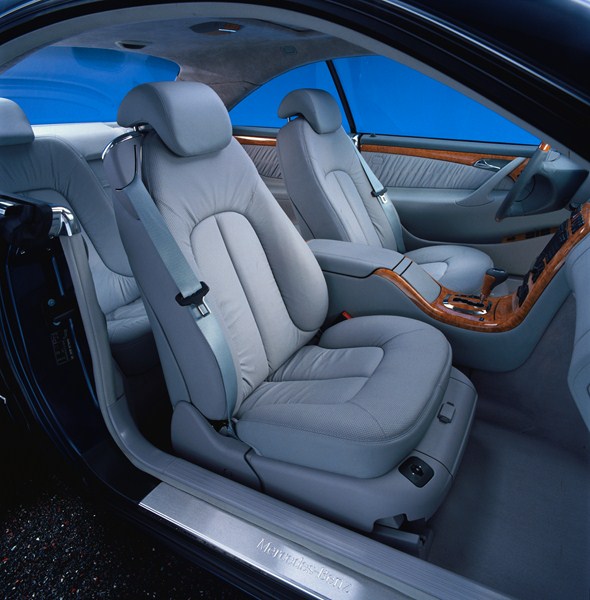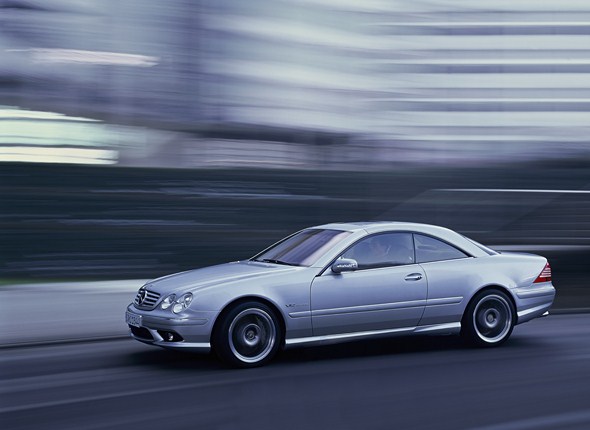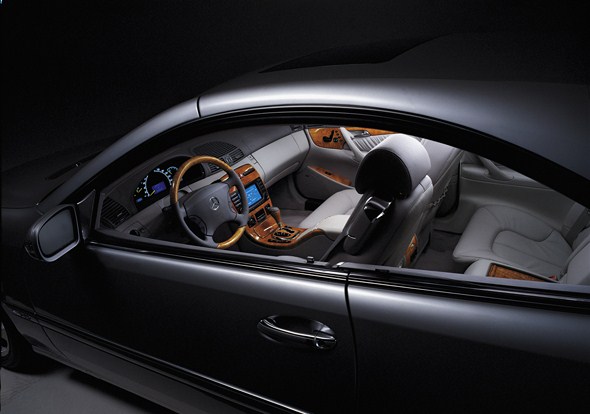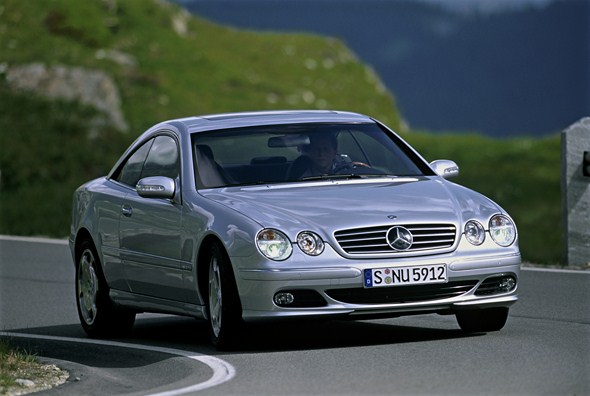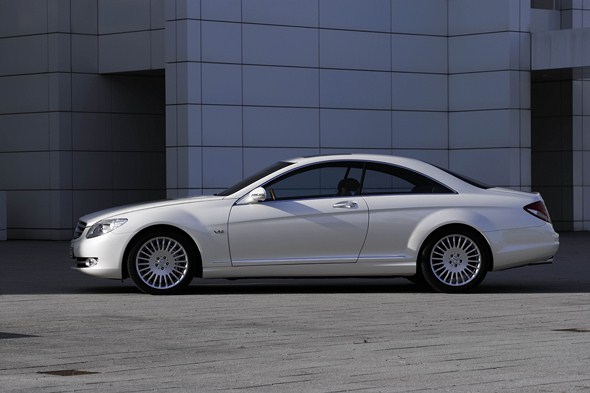

Cars for motoring pleasure at the wheel
· Elegance and technical innovation
Stuttgart – A coupé conveys clear-cut messages. Its owner buys one because of its styling and beauty, appreciates its flowing silhouette – and, in a way, dresses in it for each journey as if putting on particularly elegant attire.
The fact that a powerful engine is usually also available is regarded with favour – coupé owners after all wish to travel at brisk speeds and dynamically without sitting in a sports car.
A coupé is the continuation of a specific lifestyle on four wheels. And that is what the Coupés of the Mercedes-Benz CL-Class do in a most elegant and expressive fashion.
This is what the brochure about the C 126 series from the year 1985 had to say: “This vehicle concept has always embodied a felicitous combination of perfect engineering and out-of-the-ordinary aesthetic styling.
It is the role model for a refined sporty automobile because it additionally boasts all the other characteristics which distinguish a Mercedes.”
Mercedes-Benz has always offered coupés, with particular attention paid to the large Coupés derived from the S-Class Saloons – they are flagships not just for the company but also for the people at the wheel.
The coupé as an exclusive body design is a legacy of the automobiles from the days of the horse-drawn carriage, when the coupé – presumably so-called because it resembled a four-seater carriage with its front end cut-off (French: “coupé”) – offered two seats in the comfort of the cab with the coachman seated up front on the open box seat.
People who chose this mode of travel clearly liked to demonstrate a sense of style and individuality even before the invention of the internal combustion engine and its integration in a vehicle.
Among early automobiles the coupé retained a strong focus essentially on two persons travelling in style. By the 1950s, however, it was commonplace for coupés to have place for four people.
But the body incorporates a number of basic features that persist to this day. A coupé generally has very low, flowing lines which create a stretched silhouette.
It often dispenses with the B pillar altogether, and the C pillar slopes gently into the tail. The roof is generally shorter than in the case of a sedan, and curved at the rear.
The side windows are usually frameless.
The features also apply to the current Coupé from the C 216 series and its predecessors. Since the 1950s, in particular, the brand with the three-pointed star has been offering an uninterrupted line of exclusive coupés.
Each one addresses a clientele with a reassured taste, i.e. people who select this type of car quite consciously.
These people opt for motoring pleasure at the wheel and for driving themselves, wishing to cover even longer distances without any signs of fatigue that would be worth mentioning.
Coupé buyers enjoy a discreetly impressive appearance. For them, less is more: two doors are a statement of the generous passenger compartment’s concentration above all on the driver and the front passenger, even though virtually all large Mercedes-Benz Coupés are fully fledged four-seaters.
The four-door Mercedes-Benz CLS Coupé broadened this perspective at its debut in 2004 – showing once again how Mercedes-Benz keeps the automotive world turning.
A further highlight featuring coupé elements was the “Concept Shooting Brake“, which Mercedes-Benz presented at Auto China 2010 in April.
The car combines the elegant flowing lines of a coupé with the steep tail end of an estate.
The tradition of luxury coupés goes far back into the history of Mercedes-Benz. In addition to the classic coupés, one body design created in the 1930s for the luxury 500 K (W 29) and 540 K (W 29) models was that of the motorway courier.
The design took its name from the new high-speed motorways that were under construction in Germany at the time; compared with today, of course, these new long-distance roads had much less traffic, and with its streamlined body the motorway courier could occasionally be seen almost literally flying into the distance.
The motorway courier was the last word in state-of-the-art design – not to mention exclusivity, since anyone able to afford such a vehicle at the time certainly enjoyed grand appearances and a mobile lifestyle.
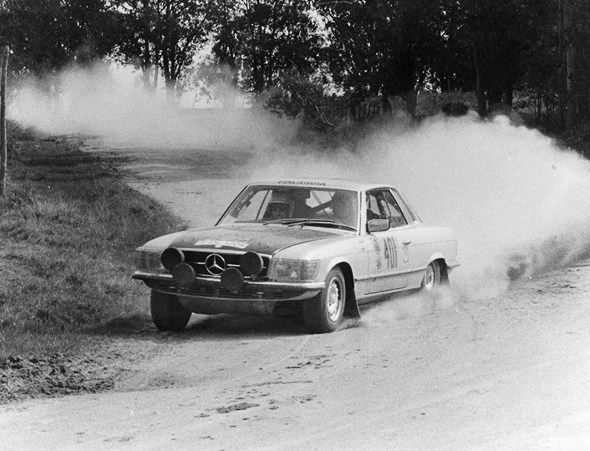
History: the CL-Class from Mercedes-Benz and its predecessors
The real story of the CL-Class and its direct predecessors goes back to the 1950s. For completeness’ sake, the list is headed by a car which, as a special version of the representational 300 Saloon, did not belong to this group of CL-Class forbears in the narrowest sense.
Nevertheless, the 300 S Coupé and 300 Sc Coupé are worthy of mention here since they made the same claim to style and exclusivity as the later CL-Class. Similarly, the SLC Coupés from the C 107 series have a place in this family history of the current CL-Class, even though these models, built from 1971 to 1981, were based on the SL touring sports car of the R 107 series.
What unites all these coupés, in addition to their styling, is the fact that they always have the latest automotive engineering on board and are thus ahead of other cars.
Because many technical innovations often make their debut both in S-Class Saloons and Coupés before being widely used in other models.
- 300 S Coupé, 300 Sc Coupé (W 188 series, 1952 to 1958)
- 220 Coupé (W 187 series, 1953 to 1955)
- 220 S Coupé, 220 SE Coupé (W 180 series/W 128 series, 1956 to 1960)
- 220 SEb Coupé, 250 SE Coupé, 300 SE Coupé, 280 SE Coupé, 280 SE 3.5 Coupé (W 111 series/W 112 series, 1961 to 1971)
- 280 SLC, 350 SLC, 450 SLC, 450 SLC 5.0, 380 SLC, 500 SLC (C 107 series, 1971 to 1981)
- 380 SEC, 500 SEC, 420 SEC, 560 SEC (C 126 series, 1981 to 1991)
- 500 SEC / S 500 Coupé / CL 500, 600 SEC / S 600 Coupé / CL 600, S 420 Coupé / CL 420 (C 140 series, 1992 to 1998)
- CL 500, CL 600, CL 55 AMG, CL 63 AMG, CL 65 AMG (C 215 series, 1999 to 2006)
- CL 500, CL 600, CL 63 AMG, CL 65 AMG, CL 500 4MATIC (C 216 series, from 2006)

Technical highlights of the CL-Class and its predecessor series
300 S Coupé, 300 Sc Coupé, W 188 series (1952 to 1958)
· Single-joint swing axle with low pivot point (300 Sc)
· Direct gasoline injection (300 Sc) 220 Coupé,
W 187 series (1953 to 1955)
· Newly designed six-cylinder engine with overhead camshaft
· Safety wedge-pin door lock to prevent the doors from bursting open
· Heater blower available
· Duplex drum brakes at the front
220 S Coupé, 220 SE Coupé, W 180/W 128 (1956 to 1960)
· Self-supporting three-box body
· Front wheel suspension with subframe
· Single-joint swing axle with low pivot point
· Brake drums with “turbo cooling”
· Hydraulic-automatic “Hydrak” clutch
220 SEb Coupé, 250 SE Coupé, 300 SE Coupé, 280 SE Coupé, 280 SE 3.5 Coupé, W 111/W 112 series (1961 to 1971)
· Safety passenger cell with crumple zones (front and rear)
· Padded steering wheel
· Wedge-pin door locks
· Disc brakes (300 SE Coupé: all-round; 220 SEb Coupé: front wheels)
· Dual-circuit brake system with disc brakes on all four wheels
(300 SE Coupé)
· Three-point seat belts
· Four-speed automatic transmission
· Air suspension (300 SE Coupé)
280 SLC, 350 SLC, 450 SLC, 450 SLC 5.0, 380 SLC, 500 SLC, C 107 (1981 to 1991)
· SL models from the R 107 series as technical basis
· Many passive safety measures
· Special wind deflection profiles on A-pillars
· Profiled rear lights for improved illumination and visibility
380 SEC, 500 SEC, 420 SEC, 560 SEC, C 126 (1981 to 1991)
· Driver airbag and belt tensioner
· Front passenger airbag from 1985
· Automatic locking differential
· Acceleration skid control (ASR)
· Drag coefficient of Cd = 0.34 (560 SEC: Cd = 0.35)
500 SEC/S 500 Coupé/CL 500, 600 SEC/S 600 Coupé/CL 600, S 420 Coupé/CL 420, C 140 (1992 to 1998)
· Electronic Stability Program ESP®
· Brake Assist (BAS)
· Xenon headlamps with dynamic headlamp range adjustment
· Tempomat cruise control operating down to 30 km/h
· Side airbags as standard
· Seat occupancy sensor for the front passenger’s seat
· Adaptive damping system (ADS)
· Front-axle subframe
· Double insulating glazing
· Speed-sensitive power steering
· Side airbags
CL 500, CL 600, CL 55 AMG, CL 63 AMG, CL 65 AMG, C 215 (1999 to 2006)
· Belt tensioners and belt force limiters in the rear
· Window airbag
· Active Body Control (ABC)
· DISTRONIC autonomous intelligent cruise control system
· Bi-xenon headlamps with wash/wipe system
· Automatic cylinder shut-off
· Drag coefficient of Cd = 0.28
· Keyless-Go keyless driver authorization system
· Active seat ventilation
CL 500, CL 600, CL 63 AMG, CL 65 AMG, CL 500 4MATIC, C 216 series (from 2006)
· PRE-SAFE® brake
· Anticipatory occupant protection system PRE-SAFE®
· ®Intelligent Light System with five light functions
· Newly developed operating concept
· Newly developed integral seats
· Parking guidance (optional equipment)
· 4MATIC all-wheel drive for the first time in a large Coupé by Mercedes-Benz (CL 500 4MATIC, since summer 2008)
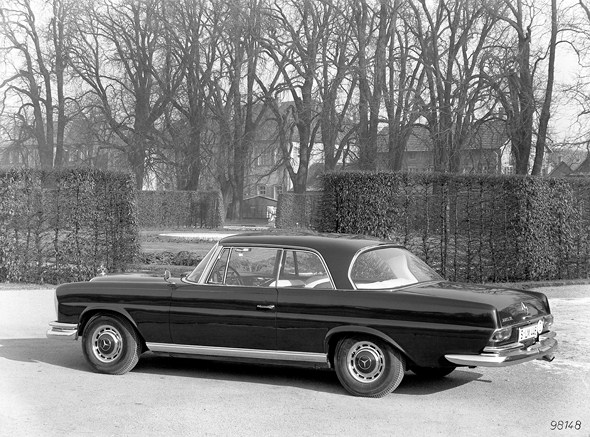
Model history – short version
300 S Coupé, 300 Sc Coupé (W 188, 1952 to 1958)
In October 1951, Daimler-Benz presented the Mercedes-Benz 300 S at the Paris Motor Show. In addition to the coupé variant, production of which began in 1952, there were also a Cabriolet A and a roadster-style variant.
In technical terms, the 300 S model was largely based on the Mercedes-Benz 300 Saloon and positioned as a particular representative car with a sporty touch – meeting the highest demands made on roadholding and speed.
The engine, with an output of 110 kW, gave the car a remarkable top speed of 175 km/h. The revised variant of the 300 Sc model made its debut in September 1955.
It was now fitted with a single-joint swing axle with a low pivot point; direct injection replacing the carburettors raised engine output to 129 kW.
Both versions, the 300 S and the 300 Sc models, ranked among the most exclusive Mercedes-Benz passenger car models in the post-war period and, like the 300 SL, are highly coveted classics among vintage car enthusiasts today.
220 Coupé (W 187, 1953 to 1955)
The Mercedes-Benz 220 Coupé came onto the market in late 1953, in response to “repeated requests by individual prominent personalities,” as a circular by the sales management put it.
In both technical and stylistic terms, the Coupé was based on the 220 Cabriolet A. The six-cylinder engine with 2.2-litre displacement initially developed 59 kW, to be replaced by a more powerful unit with 63 kW in April 1954.
The Coupé was the most exclusive version of the W 187 series – only 85 units were manufactured, which was certainly also attributable to the price of 20,850 Deutschmarks (December 1953).
Production was discontinued in July 1955; more than a year passed before a Coupé of the new 220 with three-box body was launched.
220 S Coupé, 220 SE Coupé (W 180/W 128, 1956 to 1960)
The Mercedes-Benz 220 S Coupé came onto the market three months after the debut of the 220 S Cabriolet, corresponding to the open-top version apart from having a solid roof. Both cars were based on the 220 S Saloon.
The engine with 74 kW was equally adopted, although engine output was raised to 78 kW a little later. A remarkable innovation was the hydraulic-automatic “Hydrak” clutch presented in August 1957 and optionally available for the Coupé as well. From September 1958, in addition to the carburettor model there was also the 220 SE Coupé with intermittent manifold fuel injection and an output of 85 kW.
Production of the Coupé and Cabriolet as 220 SE models continued for a little while after the discontinuation of the Saloon’s production. The engines of the last variants developed 88 kW. Production was discontinued in November 1960.
220 SEb Coupé, 250 SE Coupé, 300 SE Coupé, 280 SE Coupé, 280 SE 3.5 Coupé (W 111/W 112, 1961 to 1971)
In terms of its design and styling, the Mercedes-Benz 220 SEb Coupé was modelled on the 220 SEb fintail Saloon and therefore also belonged to the 111 series. The Coupé was a fully fledged four-seater on the Saloon’s full-length frame/floor unit.
The engine and suspension were adopted from the Saloon without any significant modifications. The only major difference was at the same time a technical titbit: the 220 SEb Coupé was the first Mercedes-Benz production car with disc brakes on the front wheels. Half a year later, the 300 SE Coupé belonging to the 112 series made its debut at the Geneva Motor Show.
When production of the fintail Saloons ended in August 1965, the Coupé and the Cabriolet remained in the range of cars for sale. However, the 2.2-litre engine was replaced by a 2.5-litre unit (logically causing the model designation to change to 250 SE Coupé).
In addition, the Coupés were given the 35.5-centimetre wheels and the larger disc brakes of the new luxury-class 108 series. In January 1968, the 280 SE Coupé with a newly developed six-cylinder engine with 2.8-litre displacement and 118 kW replaced the 250 SE Coupé, while at the same time production of the three-litre version was discontinued.
In September 1969, an additional and clearly more powerful 280 SE 3.5 Coupé version with V8 engine (147 kW) was launched. Production of the six-cylinder Coupés and Cabriolets ended in May 1971.
When production of the eight-cylinder variants was equally discontinued two months later, an era of more than ten years – that of the Coupés and Cabriolets from the 111 and 112 series – came to an end.
The rarest member of this model family was the 300 SE Cabriolet with 708 units produced; the highest production volume – with 14,173 units – within this model family was reached by the 220 SEb Coupé.
280 SLC, 350 SLC, 450 SLC, 450 SLC 5.0, 380 SLC, 500 SLC (C 107, 1981 to 1991)
The SLC Coupés of the C 107 series were not based on the current Mercedes-Benz premium class Saloon, but on the touring sports cars of the R 107 series.
From this open-top vehicles the engineers derived a four-seater Coupé with a wheelbase lengthened by 360 millimetres to 2820 millimetres.
The SLC Coupés set new standards in terms of vehicle safety. Features included a collision-protected fuel tank mounted above the rear axle, a padded instrument panel and the new four-spoke safety steering wheel with impact absorber and broad padded boss for maximum impact protection.
The first vehicle to be presented in 1971 was the 350 SLC (147 kW), launched in 1972. That same year came the 450 SLC (165 kW), and finally in 1974 the powerful 136 kW 280 SLC with 2.8-litre injection engine.
In 1977 Mercedes-Benz then introduced the 450 SLC 5.0 (177 kW) as the new flagship model in the C 107 series – launched on the market in 1978, this vehicle had no counterpart in the open-top R 107 series unlike the other SLC Coupés. In 1980 Mercedes-Benz updated both the SLC Coupés and the open-top vehicles of the R 107 series.
The 450 SLC 5.0 (in line with its displacement of 4939 cubic centimetres) became the 500 SLC. The 350 SLC was simultaneously succeeded by the new 380 SLC with its 3.8-litre light alloy engine. In a production period of ten years the C 107 series gave rise to a total of 62,888 examples of the Mercedes-Benz SLC.
380 SEC, 500 SEC, 420 SEC, 560 SEC (C 126, 1981 to 1991)
The 380 SEC and 500 SEC Coupé variants from the C 126 series were launched at the Frankfurt International Motor Show in September 1981.
They were again based on the S-Class Saloon, and the chassis was identical with that of the Saloon with the exception of detail modifications. Although the frame/floor unit had been shortened by 85 millimetres, the cars were still fully fledged four-seaters.
The bodywork was designed along the lines of the latest findings in safety research. Interesting features were electrically operated belt feeders which formed part was of the standard specifications of the SEC models.
In addition, an airbag for the driver and a belt tensioner for the front passenger were optionally available. In 1985, an extensive model refinement package included not only a discreet facelift but also, and above all, a restructured engine range.
A new unit was a V8 engine with 4.2-litre displacement. The 5.0-litre engine was also modified and upgraded with electronic ignition and electronically/mechanically injection.
The most spectacular novelty was a 5.6-litre eight-cylinder engine which generated an output of 200 kW and as much as 221 kW in a version with a higher compression ratio (though without catalytic converter).
The 560 SEC and 560 SEL models equipped with this engine were the most powerful Mercedes-Benz production cars built until then. Production of the SEC Coupés was discontinued at the end of 1991, almost exactly ten years after their market launch.
The total production volume of 74,060 units was an indicator of the great popularity of this model family. Clearly the rarest version was the 420 SEC with just 3,680 units.

500 SEC/S 500 Coupé/CL 500, 600 SEC/S 600 Coupé/CL 600, S 420 Coupé/CL 420 (C 140, 1992 to 1998)

Initially, two variants of the Coupé from the 140 series were offered: the 500 SEC (V8 engine, 235 kW) and the 600 SEC (V12 engine, 290 kW).

In engineering terms, they were based on the S-Class Saloons launched in 1991; unlike the predecessor Coupés from the 126 series, however, they were stylistically more independent from the corresponding Saloons.
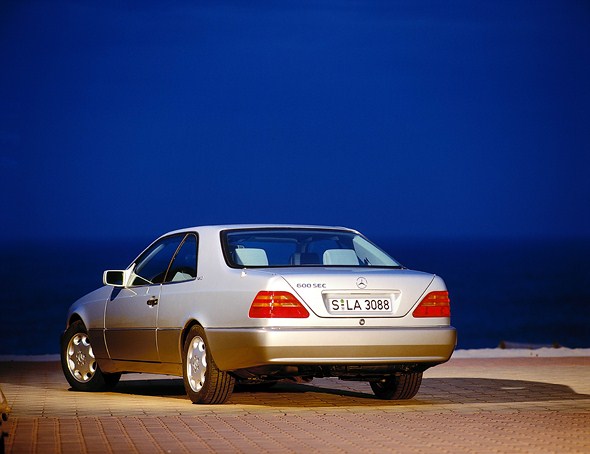
Analogous to the other passenger car models from Mercedes-Benz, new model designations were introduced for the large Coupés as well in June 1993; the 600 SEC, for example, became the S 600 Coupé. In 1994, the Coupé family was extended by the addition of the S 420 Coupé (V8 engine, 205 kW).

Two fundamental technical innovations became available in the S 600 Coupé for the first time: in May 1995, a completely newly developed five-speed automatic transmission with slip-controlled torque converter lock-up clutch and electronic control was introduced.

Another innovation was the Electronic Stability Program ESP®. In 1996, the model designations of the Coupés were changed once again.

The series was now called CL – and this was no end in itself but reference to the fact that the large Coupés had adopted the pacemaker function for the entire coupé family. Production of the CL models from the C 140 was discontinued in September 1998 after a total of 26,022 units had been built.
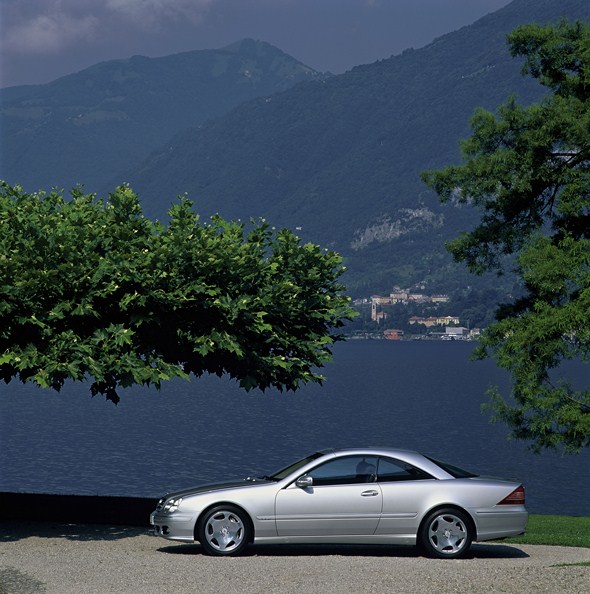
CL 500, CL 600, CL 55 AMG, CL 63 AMG, CL 65 AMG (C 215, 1999 to 2006)
In the autumn of 1999, the new CL Coupé from the C 215 series was available in the dealerships. Initially, there was only the CL 500 with V8 engine (225 kW), which was complemented by the CL 600 with twelve-cylinder engine (270 kW) in early 2000.

The standard equipment of the new large Coupés included, among other things, an extensive safety package with different airbags. Another standard – and at the time globally unique – feature was the novel active suspension system, Active Body Control (ABC).

It almost completely compensates for roll and pitching movements when starting off, cornering and braking. The twelve-cylinder engine of the CL 600 was fitted with automatic cylinder shut-off as standard, which was optionally available for the eight-cylinder unit in the CL 500 and lowered the fuel consumption in the part-load range.

From the fall of 2000, the CL 55 AMG “F1 Limited Edition” of just 55 units became available. It was the world’s first road-going car with a brake system featuring ceramic brake discs.

The CL 63 AMG (326 kW) followed in 2001. For the model refinement in 2002, the front and rear sections of the large Coupés were discreetly refined.

A major innovation was the V12 biturbo engine in the CL 600, which developed 368 kW and generated a maximum torque of 800 Newton metres upwards of 1800/min at a charge pressure of one bar.

From the fall of 2002, the CL 55 AMG boasted a supercharged V8 engine with a displacement of 5.5 litres and an output of 265 kW. The engine of the CL 500 remained unchanged. The safety equipment of the series was enhanced still further.
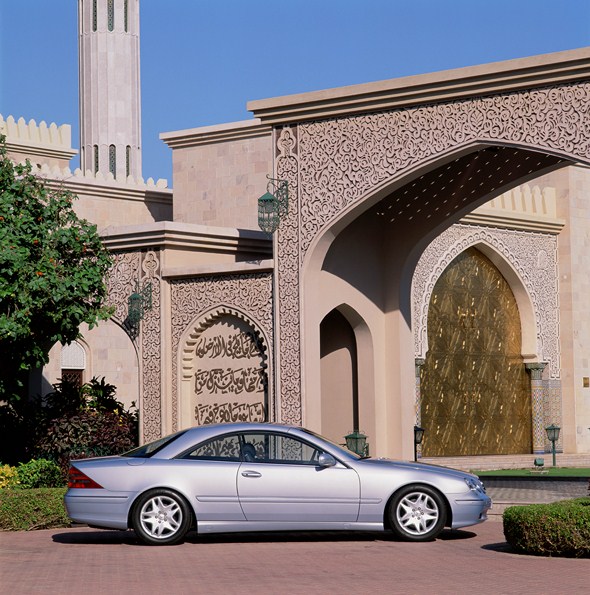
Then, in the fall of 2003, the CL 65 AMG (450 kW) joined the ranks of the large Coupés. The C 215 proved to be a decidedly successful series: 47,984 Coupés had been sold by 2006.
CL 500, CL 600, CL 63 AMG, CL 65 AMG, CL 500 4MATIC (C 216, from 2006)
The CL Coupé from the C 216 series appeared in autumn 2006. The two-door model combined utmost exclusivity and sophisticated design with pioneering technology.
This included the PRE-SAFE® brake, for example, the system that automatically applied the Coupé’s brakes in the event of a potential front-end collision. Initially there was a choice of two powerful engines with eight or twelve cylinders in the CL 500 (285 kW) and CL 600 (380 kW) respectively.
Compared with the predecessor series these offered a clear bonus in terms of output and torque and with their exemplary smooth running characteristics matched the Mercedes claim of outstanding refinement.
At the Paris Motor Show in September 2006 Mercedes-Benz presented the CL 63 AMG with its AMG-developed 6.3-litre V8-engine. This had a peak output of 386 kW and torque of 630 Newton metres. The new 12-cylinder top-of-the-range CL 65 AMG model (450 kW) was unveiled the following year at the New York International Auto Show 2007.
From summer 2008 Mercedes-Benz also offered the luxury Coupé from the CL-Class with all-wheel drive. This gave the new CL 500 4MATIC an even higher level of traction and handling stability in wet, snowy or icy conditions.
For model year 2011 the C 216 series underwent a major model refinement which brought the vehicles up-to-date in technical and design terms – thereby perpetuating the fascination with large Coupés from Mercedes-Benz.

Exclusive start to the new Coupé tradition: the W 188 series (1952 to 1958)
· A representative car with a sporty touch
· Technically affinity with the Mercedes-Benz 300
· Just 314 units built
In October 1951, Daimler-Benz launched the Mercedes-Benz 300 S at the Paris Motor Show – one month before production of the 300 Saloon (W 186) began.
The company thus had two top-of-the-range models in its portfolio. The 300 S was positioned as a particular representative car with a sporty touch – meeting the highest demands made on roadholding, safety and speed.
The 300 S met all of these expectations, as reflected by the verdicts of the international motoring press. The latter described the new model as “the car for the world elite” and “the yardstick for what is feasible in contemporary automotive engineering.
” The press also praised the “traditional and, in this case, particularly noble lines … without resorting to aerodynamic gimmickry.” According to the original brochure, the 300 S was a refined car: “The Mercedes-Benz 300 S is a car which will not only inspire the sporty driver but will also make it possible to cover the longest distances in the shortest time and with minimum strain on one’s body and nerves.
” The brochure also enthused about the “composed, elegant lines which harmonize exceptionally well with a modern design.”
In technical terms, the 300 S was largely based on the Saloon version of the 300 model (W 186) but had a 140 millimetre shorter chassis.
Engine output was boosted to 110 kW through an increase in the compression ratio and the fitting of as many as three carburettors, giving the car a top speed of 175 km/h.
Alongside the Coupé, the 300 S was also offered as Cabriolet A and Roadster versions. Production of the three variants started between June and September 1952. In total 216 examples of the Mercedes-Benz 300 S Coupé were built during the following four years.
Direct injection instead of carburettors
At the Frankfurt International Motor Show in September 1955,
Daimler-Benz presented a revised Saloon, the Mercedes-Benz 300c, and an equally refined version of the 300 S. The most important modifications had been made on the rear axle and the engine.
Like the Saloon, the refined model, internally named 300 Sc, now had a single-joint swing axle with a low pivot point. Mixture formation was no longer by three carburettors but by direct injection; with the compression ratio raised at the same time, this boosted engine output to 129 kW.
The original brochure had this to say: “The felicitous combination of the highest performance and driving safety with refined elegance and unique quality has caused the Mercedes-Benz 300 S to quickly become a car of choice in the international luxury class.
It is the world’s first large touring car to feature a direct-injection engine modelled on the famous 300 SL production sports car.”
The bodywork had also been modified in several respects. The 300 Sc had quarterlights next to the side windows as well as larger direction indicators at the front and rear.
Other distinguishing features were two horizontal, chrome-trimmed ventilation louvers on both sides underneath the engine hood, as well as chrome strips running all the way from the front to the rear wheel cut-outs.
Reference to the more powerful engine was made in the form of the chromed lettering INJECTION ENGINE fitted on the trunk lid underneath the handle.
Special suitcases included in the standard equipment
In view of all its qualities, the vehicle was the ideal car for travel. Two special suitcases were included in the standard equipment to allow optimum use to be made of the spacious trunk.
Two additional suitcases were available at an extra charge; they were accommodated in the rear compartment after the rear seat bench had been folded away – and were ideal for very long journeys for driver and passenger.
Despite the technical and stylistic improvements, only 200 units were produced of all three bodywork versions of the 300 Sc Coupé. From early 1957, the customers’ interest in this model and its sister models began to dwindle – which is why production of the 300 Sc was discontinued in April 1958.
The reasons for this were to a certain extent attributable to the launch of the 300 SL Roadster, which was obviously the more attractive offer for many prospective buyers – being as much as 4,000 Deutschmarks less expensive despite its more contemporary styling and higher performance.
With total production figures of just 314 units, the two versions – 300 S Coupé and the 300 Sc Coupé – rank among the most exclusive Mercedes-Benz passenger car models of the post-war period and, like the 300 SL, are highly coveted among classic car enthusiasts.
W 188 series in the press
Road & Track, USA, April 1953, about the Mercedes-Benz 300 S:
“Wherever the Mercedes-Benz 300 S has been seen, since its first appearance at the Paris Salon in the autumn of 1951, it has caused a quiet riot of enthusiasm, with its low, sleek lines and its attitude of ‘going’ even when standing still.”
Road & Track, USA, January 1999, Karl Ludvigsen in a review of the Mercedes-Benz 300 S:
“So extraordinary were these ‘S’ models, such rare and exceptional birds were they, that even when Italian-bodied they were close to the hearts of the Stuttgart engineers and craftsmen. They were proud of what they had achieved with these custom-bodied big Mercedes, the last of their line. Their pride was fully justified.”
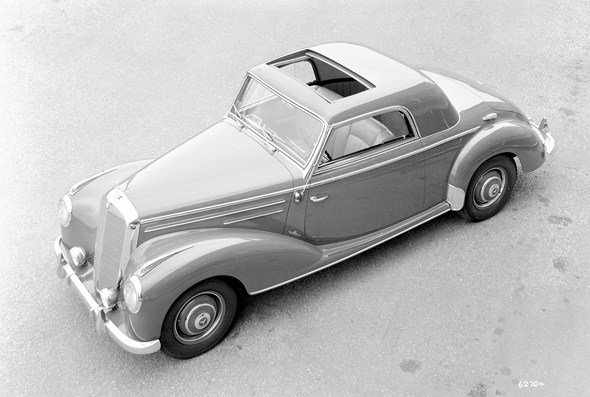
Elegant Coupés in small series: the W 187 series (1953 to 1955)
· The rarest version in the 187 series – just 85 units built
· Basis provided by the Mercedes-Benz 220 Cabriolet A
The Mercedes-Benz 220 Coupé belonged to the W 187 series which Daimler-Benz presented at the Frankfurt International Motor Show in April 1951 together with the 300 (W 188 series) – initially with a Saloon body.
The 220 was largely based on the 170 S but had a newly developed six-cylinder engine with overhead camshaft, which developed 59 kW from a displacement of 2.2 litres.
Drivers thus had adequate power at their disposal as the car was capable of reaching a top speed of 150 km/h. Chassis and bodywork were almost identical – only the headlamps had now been integrated in the specially modified front fenders.
To match the significantly higher engine output, the 220 was fitted with duplex brakes on the front wheels. There was a choice of three bodywork versions to start with: Saloon, Cabriolet A and Cabriolet B. In addition, a total of 41 open-top touring cars were produced for the police between August 1952 and May 1953.
The two Cabriolets were positioned as sporty touring cars with an exclusive character. In December 1953, they were joined by a Coupé which lay claim to the same characteristics – in response to “repeated requests by individual prominent personalities,” as a circular by the sales management put it.
Utmost exclusivity: just 85 units produced
In both technical and stylistic terms, the Coupé was based on the Cabriolet A. The sporty touch was emphasized by a slightly curved – rather than flat – windshield which the Cabriolet A had already been featuring from November 1953.
In terms of sales price and the number of units produced, the Coupé moved on to become the most exclusive version of the W 187 series – just about 85 units of this model were manufactured whereas the combined production volume of all the other versions came to more than 18,400 – including 1,278 Cabriolet A units.
Exclusivity was also expressed by the price: the Coupé cost 20,850 Deutschmarks – and 22,000 DM with steel sunroof (December 1953); for the Cabriolet A, 18,850 DM had to be paid (February 1952); by comparison, the Saloon with a price tag of 11,750 DM (February 1952) appeared to be decidedly inexpensive.
From April 1954, the Coupé and the Cabriolet A were equipped with an engine with a higher compression ratio and a higher output of 63 kW, a unit which had already been developed for the successor model, the 220a production of which began in June 1954.
Production of the 220 Saloon was discontinued in May 1954, the last Cabriolet B having come off the assembly line in Sindelfingen one year earlier already.
The Coupé and the Cabriolet A continued to be built until July and August 1955, respectively. More than a year was to pass before three-box body versions of the Coupé and Cabriolet became available from the new Mercedes-Benz 220 series.
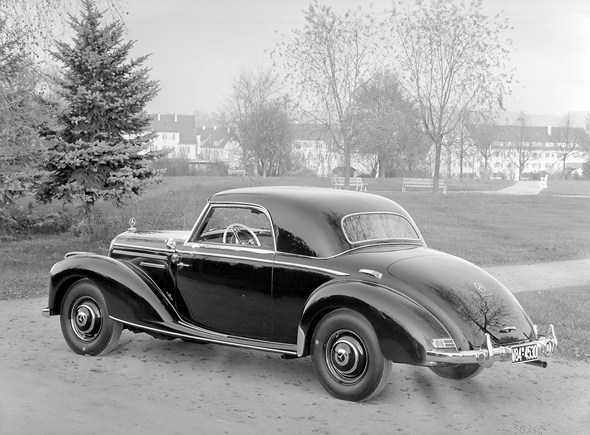
The three-box body matches the Coupé ideal: the W 180/W 128 series (1956 to 1960)
· A Coupé to go with the Saloons of the “Ponton” series
· ‘Hydrak’ hydraulic automatic clutch available as an option for the first time
The Mercedes-Benz 220 S Coupé made its debut three months after the launch of the 220 S Cabriolet, corresponding to the open-top version with the exception of featuring a solid roof.
Both cars were based on the 220 S Saloon launched in March as the successor to the 220a. It was from the Saloon that the engine with an output of 74 kW was adopted, providing the Coupé with adequate power for a top speed of 160 km/h and an acceleration from 0-100 km/h in 17 seconds.
The latter came with extensive standard specifications as the brochure pointed out: “The representative, sporty bodywork encloses a luxuriously equipped interior compartment, with fine-wood dashboard trim and window surrounds, leather-covered upholstery, heating and ventilation with a blower for the stationary car and clearly laid-out gauges.”
The brochure had this to say about the bodywork: “The characteristic ‘face’, the strong bumpers with bumper horns, the fog lamps and direction indicators, the laterally projecting and curved rear screen of the Coupé and, not least, the forward-pushing, elongated lines of the bodywork from Sindelfingen – everything is perfectly matched into a harmonious entity.”
In August 1957, improved versions of virtually all passenger car models were presented under the motto “Even more valuable, but not more expensive” – among them refined versions of the 220 S Coupé and Cabriolet, with discrete modifications and an engine output boosted to 78 kW.
The only externally visible modifications were those to the front bumper and number plate panel and the illumination of the rear number plate, which, as on the Saloons, had been relocated into the bumper horns.
A remarkable innovation was the hydraulic automatic clutch, “Hydrak”, which was equally presented in August 1957 and made optionally available for the Coupé as well.
Improved engine and automatic clutch
From September 1958, and at the same time as the Saloon, the Coupé and Cabriolet were also offered with a gasoline injection engine – in the form of the 220 E.
With the exception of this engine, the Coupés and Cabriolets, internally known as the W 128, were largely identical with the 220 S sister models with carburettor engines.
The six-cylinder unit with a displacement of 2.2 litres differed from the proven engine in the 220 S only with respect to the mixture formation which was now accomplished by means of intermittent manifold injection – as in the 300d Saloon; output was thus raised to 85 kW.
However, the improved performance and the slightly greater fuel economy of the model with injection engine came at a surcharge of 1,900 Deutschmarks.
Another 450 Deutschmarks had to be paid for the optionally available hydraulic automatic clutch, “Hydrak”.
In August 1959, three completely newly designed six-cylinder models with fintail bodywork were presented, and production of the 219, 220 S and 220 SE three-box body Saloons was discontinued in the same month.
Only the 220 SE Coupé and Cabriolet continued to be built – the last versions with carburettor engines came off the assembly lines in October 1959.
From August 1959, the modified injection engine from the 220 SEb was installed in both models – a unit which generated an output of 88 kW thanks to straight intake pipes and a steeper-angled camshaft.
Production of the 220 SE Coupés and Cabriolets finally ended in November 1960; the successors – a new Coupé and a new Cabriolet – were launched in February 1961 and August 1961, respectively.
With a total volume of 2,081 units – including 830 with injection engines – the three-box body Coupés ranked among the rare models from Mercedes-Benz post-war production.
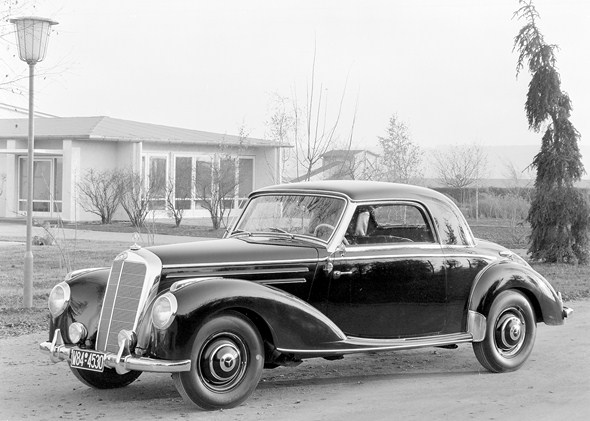
Elegant interpretation of the fintail: the W 111/W 112 series (1961 to 1971)
· A large four-seater Coupé in the S-Class format
· Numerous engine variants up to the V8 unit
Within the framework of the inauguration of the Daimler-Benz Museum in Untertürkheim on February 24, 1961, the new Mercedes-Benz 220 SEb Coupé was launched.
The elegant and representative new design was the successor to the 128-series Coupé production of which had been discontinued as early as October 1960.
In terms of its engineering and styling, the new car was modelled on the 220 SEb Saloon presented in August 1959 and likewise allocated to the 111 series.
Unlike its predecessor, the Coupé was based on the full-length frame/floor unit of the Saloon and was therefore a fully-fledged four-seater.
Although the fintails – which caused quite a stir when the 220b and 220 SEb were presented – were only rudimentary on the new Coupé, both Coupé and Saloon had numerous stylistic features in common.
It is therefore all the more surprising that the Coupé did not share a single body-in-white part with the four-door model.
Engine and chassis were adopted from the Saloon without any modifications worth mentioning. The only significant difference was also a technical titbit: the 220 SEb Coupé was the first Mercedes-Benz production car equipped with disc brakes on the front wheels.
In August 1961, a Cabriolet variant of the 220 SEb was introduced, corresponding in all its details to the Coupé with the exception of the soft-top and the required bodywork reinforcements.
Additional model with three-litre engine
Six months later, the 300 SE Coupé and 300 SE Cabriolet made their debut at the Geneva Motor Show – created, in a way, from parts from a modular kit.
The bodywork of the related 220 SEb variants were fitted with additional trim and combined with the engineering of the 300 SE.
Accordingly, the new exclusive models – allocated to the 112 series like the basic Saloon – were equipped with a whole series of special technical features.
The standard specifications included a light-alloy engine with a displacement of three litres, a four-speed automatic transmission, power steering, air suspension and a dual-circuit brake system with disc brakes on the front and rear wheels.
The additional chrome trim consisted of a chrome strip running in the longitudinal groove from the headlamps all the way to the rear lights, as well as of distinctive trim strips on the front and rear wheelarches.
A brochure of 1953 commented on the design: “From whichever angle one looks at this car, one is always struck by its racy elegance and aesthetic balance of stylistic elements.
It is its superior appearance – forward-looking, yet without a hint of fashionable gimmickry – which holds the observer in its thrall.”
From March 1963, the 300 SE Coupé and Cabriolet as well as the Saloon became optionally available with a four-speed manual transmission, reducing the list price by 1,400 Deutschmarks.
In January 1964, engine output was raised to 125 kW, resulting in improved performance. This increase in output was made possible by replacing the injection system by a six-plunger injection pump.
A one-off unit for the Chief Engineer
A special one-off version of the 300 SE Coupé was set up in the test department in 1962. The rear end of the roof with the rear screen was removed and replaced by a recessible folding top.
The result of this modification was a landaulet which was driven by chief engineer Fritz Nallinger for several years. Unfortunately, nothing is known about the subsequent fate and whereabouts of this interesting one-off car.
When the 220 Sb, 220 SEb and 300 SE fintail Saloons were replaced by a newly designed generation of models in August 1965, the Coupé and Cabriolet versions remained in the sales range for the time being.
These exclusive models, which had been in production for four years at the time, were far from looking outdated alongside the new-generation Saloons, so that an expensive stylistic refinement or even a new development of the small-series versions was not necessary.
The brochure promised this: “You will see for yourself that Mercedes-Benz passenger cars will give back to you something that has become extremely rare in today’s road traffic: your freedom and composure.”
Several new features introduced with the new Saloons were also incorporated in the Coupés and Cabriolets. The two 2.2-litre models were given the 110 kW 2.5-litre engine of the 250 SE and the corresponding model designation.
Like the three-litre models, they were also equipped with the larger wheels (diameter: 35.5 centimetres) and the larger disc brakes of the 108 luxury series.
Another new feature was the hydropneumatic compensating spring on the rear axle, fitted in place of the previous coil spring in the 2.5-litre models and keeping the car at a constant level irrespective of the load in the car.
In January 1968, the 280 SE made its debut, succeeding the 250 SE with a newly developed 2.8-litre six-cylinder engine with 118 kW.
This change of generation affected both the Saloon and the two two-door versions. With the exception of the new engine, only detail modifications were made on the Coupé and Cabriolet: like the Saloon, both models were given flatter, undivided wheel embellishers with integrated hub caps.
Production of the 300 SE Coupé and Cabriolet was discontinued at the same time as that of the 2.5-litre models.
A direct successor was not planned for the time being but wasn’t really necessary, either, as the 2.8-litre engine developed only a little less output (7.4 kW) but had a comparable performance on account of its considerably reduced weight.
All-new V8 engine
In September 1969, clearly more powerful versions of the 280 SE 3.5 Coupé and Cabriolet were introduced. The completely newly developed 3.5-litre V8 engine with an output of 147 kW excelled in particularly smooth running characteristics and gave the car a sports-car-like performance.
The new models had been stylistically refined to a certain extent, like the versions with 2.8-litre six-cylinder engines which continued to be on sale: the radiator mask was lower and wider, with a correspondingly flatter front end of the engine hood.
Due to this characteristic feature, the face-lifted Coupés and Cabriolets were often referred to as the “flat radiator” models by insiders. As on the Saloons, the bumpers of the Coupés and Cabriolets were now fitted with rubber strips.
In purely visual terms, the eight-cylinder models did not differ from the face-lifted six-cylinder versions.
Production of the six-cylinder Coupés and Cabriolets was discontinued in May 1971. When production of the eight-cylinder models ceased two months later, the era of the Coupés and Cabriolets from the 111 and 112 series came to an end after more than ten years.
In the Sindelfingen plant, 28,918 Coupés and 7,013 Cabriolets had been produced. The highest production volume within the model family had been reached by the 220 SEb Coupé with 14,173 units.
There were no direct successors to the Coupés from the W 111 and 112 series. Instead, Mercedes-Benz offered Coupés from the C 107 series, whose engineering was based on that of the SL, between 1971 and 1981.
W 111 and W 112 series in the press Auto, Motor und Sport, Germany, no. 7/1962, about the Mercedes-Benz 300 SE Coupé: “This year, something new is shown in Geneva – no sensations but at least a couple of surprises.
The latter include the Coupé and Cabriolet versions of the Mercedes-Benz 300 SE – a combination of the engine and chassis from the 300 SE with the bodywork of the 220 SE Coupé and Cabriolet, respectively.
With its 160 hp three-litre injection engine, automatic transmission, power steering, air suspension, disc brakes on all four wheels, locking differential and exclusive appointments, this car is clearly the ultimate in modern automotive engineering.”
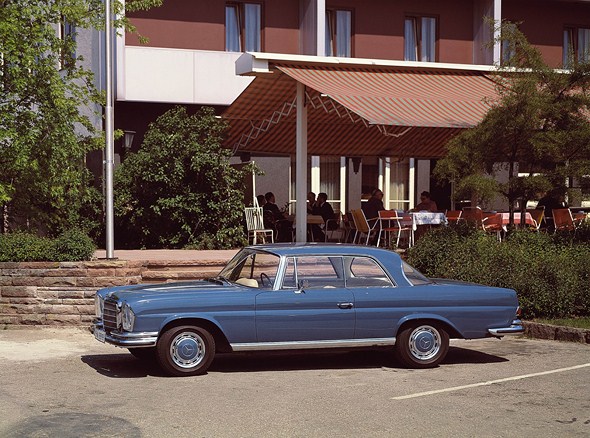
Coupés based on a touring sports car: the SLC models of the C 107 series (1971 to 1981)
· A coupé with the claim of the Mercedes-Benz S-Class
· Technical basis is the SL series R 107
· Sports versions win honours at many rallies and long-distance events
When the new touring sports car of the R 107 series was presented in April 1971, the issue of whether to a new large Coupé should be developed at Mercedes-Benz still remained unanswered.
Discussion centred on whether one should additionally, and in the near future, design a four-seater sports coupé based on the R 107 series, or wait for the coming S-Class (116 series) to build it on that basis. But in that case a production model would not have arrived until much later, in the mid-1970s.
Karl Wilfert, then the head of Body Design in Sindelfingen, developed – pretty much on his own authority – a Coupé based on the R 107 and presented it one day to the Board of Management as a “rough draft”.
Rejected at first, Wilfert managed to push through his idea of a sports Coupé with the tenacity which was so characteristic of him.
And so six months after its premiere the SL Roadster was followed in October 1971 by a comfortable four-seater Sports Coupé, the 350 SLC, whose unconventional lines also found it many friends around the world in the course of the years. The series was given the internal designation C 107.
The open-top vehicles of the SL series as a basis
The technical basis was the SL series R 107. This touring sports car was a powerful, self-confident and representational open-top vehicle, which had additionally been equipped with an equally successful detachable Coupé roof by its designers.
In addition to elegance and safety, the body also exuded safety, since the two-seater’s crash behaviour was already well ahead of its time.
The decision to manufacture the R 107 series (“R” as in Roadster instead of “W” as in Wagen = car) was taken by the Board of Management after intensive debates on 18 June 1968.
At dispute was whether there should be a Targa-roof version, i.e., one with a removable roof panel, instead of the fabric-topped variant, because owing to higher safety standards alarming news was to be heard from the USA regarding the licensing of open-top cars.
The head of development at the time, Hans Scherenberg, pushed through the decision to go ahead with an open-top two-seater with a fabric roof and an additional removable hardtop.
Up to the windscreen its appearance matches that of the open-top variant; behind the windscreen the overall height and length grows.
A flat roof spans the four-seater passenger compartment in a gentle curve, going over into a large and very steep rear window that arches in two directions. The boot lid is slightly convex in shape, unlike that of the SL.
In the side view the length of the Coupé is documented, firstly, by the 360 millimetre longer wheelbase (2820 millimetres versus 2460), secondly by the line of the side windows.
Without awkward B-pillars they are completely retractable, as is usual in a Mercedes-Benz Coupé. The SLC’s coefficient of drag is better than that of the SL so that the Coupé attains the same performance despite an added weight of some 50 kilograms.
A particularly noteworthy fact is that it fully lived up to its classification as a “Sports Coupé”, gaining wins for Mercedes-Benz in many rallies and long-distance races.
Safety as a matter of course
Béla Barényi’s safety concept with front and rear crumple zones and a rigid passenger cell found expression in the 107 series in a further developed form.
The backbone of the R 107 series is not simply a shortened and reinforced Saloon floor assembly, as in the predecessor, but an independent frame-floor unit with a closed transmission tunnel and box-shaped cross and longitudinal members which featured differing sheet metal thicknesses and a resultant carefully defined crumple pattern.
The SL definitely had to be an open-top car, and that being the case the only protection in a possible roll-over would be provided by the A-pillar plus windscreen.
They were thoroughly redesigned and had 50 percent more strength to show than in the previously built version. In addition, to enhance its strength the windscreen was bonded into the frame.
This resulted in a remarkable power of resistance in the roof-drop test with the result that the open-top car could be licensed for the USA even without a Targa bar. The SLC Coupé also benefited from this design.
In the interior the hard dashboard made way for an ingenious sheet-steel design that yields on impact both in the top section and the knee area and is foam-padded.
The switches and levers were recessed. Another new feature: the four-spoke steering wheel based on the latest findings of accident researchers. The proven impact absorber was still in place, but the steering-wheel rim, spokes, padded boss and hub were covered with polyurethane foam.
As further safety feature the fuel tank was no longer installed in the rear end but above the rear axle, protected against collision. The anti-lock braking system ABS was available from March 1980.
Characterful Coupé with innovative details
Like the Roadster, the Coupé met with a very favourable response. Its distinctive front end with the dominant SL face, the wide-band headlamps and grooved indicator covers had a powerful aura; the lines of the low silhouette were harmonious.
The wide-band tail lights with their ribbed surface not only were largely insensitive to soiling, but additionally gave the rear end a touch of vigour.
A number of details underscored the car’s safety aspirations. The seats were available from the start with head restraints, and seat belts also were included.
Physical well-being and driver-fitness safety were served by the heating system with its very spontaneous response, supported by new air ducting at the doors.
Newly developed wind-deflecting mouldings on the A-pillars, which also served to channel off mud-laden water in the rain, and dirt-repelling covers on the exterior mirrors enabled good visibility.
They kept the side windows clean even in inclement weather. The windscreen wipers arranged closely to each other in the centre of the car swept a respectable 70 percent of the windscreen area, were always optimally positioned in the flow of air and did not lift off even at higher speeds.
Varied range of engines
On account of its shorter production period and the fact that the 450 SLC 5.0 was only available as a Coupé, the range of engines in the C 107 series was different to that of the R 107 series.
The eight-cylinder models were led by the 350 SL (1971 to 1980), whose 3.5-litre engine (M 116) already was known from the W 108, W 109 and W 111 series. The 147 kW which it delivered at 5800 rpm helped the SL, which tipped the scales at around 1600 kilograms, to clock nine seconds for 0 to 100 km/h with a top speed of 210 km/h.
Then in 1972 Mercedes-Benz launched the 450 SLC, whose engine (M 117) developed an output of 165 kW at 5000 rpm. Top speed was 215 km/h, and it needed 8.8 seconds to go from 0 to 100 km/h.
Like the 450 SL, the 450 SLC was destined exclusively for export to North America prior to March 1973; after that Mercedes-Benz included them in the general sales range.
In July 1974 the SL model range was extended: as a consequence of the oil crisis of 1973, the SL and SLC now were available as models 280 SL and 280 SLC with the 2.8-litre M 110 engine.
It developed 136 kW at 6000 rpm and had proven its reliability in the two years before in the “Stroke Eight” series W 114/115 and in the 116-series S-Class.
Both models had identical performance: the top speed was 205 km/h; sprinting from 0 to 100 km/h in 10.1 seconds was possible.
So three SLC engine variants were now available.
Only the attentive observer could distinguish between the three variants: The 280 SL could be recognised by its narrower tyres in comparison to the 350 SLC and the 450 SLC. In addition, the 450 SLC featured an inconspicuous front spoiler which was attached to the rear lower end of the front apron and distinctly increased the radiator’s air throughput.
Between November 1975 and February 1976 the fuel injection systems of all three engines were changed for better compliance with the emission standards, which meanwhile also had become stiffer in most European countries.
The electronically controlled Bosch D-Jetronic was abandoned for the newly developed mechanically controlled Bosch K-Jetronic. The changeover entailed minor losses in performance in all three cases: in the 280 SLC to 130 kW at 6000 rpm, in the 350 SLC to 143 kW at 5500 rpm, and in the 450 SLC to 160 kW at 5000 rpm.
At the same time the compression ratios of the 2.8 and 3.5-litre engines were slightly reduced. The 3.5 and 4.5-litre engines additionally got a contactless transistorised ignition and hydraulic valve play compensation to facilitate maintenance.
The compression ratio of the 2.8-litre unit was raised to the old figure again in April 1978. With a few supporting measures the engine then regained its earlier power potential of 136 kW, but now already at 5800 rpm.
In September 1977 Mercedes-Benz launched the 450 SLC 5.0 with a V8 engine (M 117) enlarged to a displacement of five litres. A hidden innovation was the first-time application of hypereutectic cylinder contact surface machining, which made it unnecessary to insert cylinder liners.
The engine delivered 177 kW at 5000 rpm, good for zero to 100 km/h acceleration in 8.5 seconds and a top speed of 225 km/h. The vehicle’s bonnet and boot lid were made of aluminium, and it had light-alloy wheels as standard.
On the outside, the 450 SLC 5.0 was recognisable by, among other things, a narrow spoiler on the rear end. This model had no roadster equivalent.
Series revision
At the Geneva Motor Show in March 1980 the SLC and SL series presented themselves in updated form. The interior appointments including steering wheel were matched to those of the 126-series S-Class, and the engineering was brought up to the same level.
The previous three-speed automatic transmission with torque converter was replaced with a four-speed variant. The 280 SLC model was given a five-speed manual transmission as basic equipment.
The six-cylinder engine of the 280 SLC remained unchanged. The 350 SLC was sent off into retirement and succeeded by the 380 SLC, whose 3.8-litre light-alloy engine (M 116), with 160 kW at 5500 rpm, originated after the pattern of the five-litre unit, by enlarging the bore of the long-serving 3.5-litre V8 with grey cast iron cylinder block.
The 380 SLC attained a top speed of 215 km/h and needed nine seconds for the sprint from 0 to 100 km/h.
Parallel to the introduction of the new 500 SL, which was fitted with the 5.0-litre V8-engine (M 117) from the 450 SLC 5.0, the Coupé was renamed the 500 SLC.
All three SLC models were now equipped with the light-alloy bonnet and front spoiler familiar from the 450 SLC 5.0, while the light-alloy boot lid with black plastic rear spoiler remained reserved for the top-of-the-range model.
The successors to the C 107 series, the 380 SEC and 500 SEC of the C 126 series, were presented at the Frankfurt International Motor Show in September 1981. During its ten-year period of production a total of 62,888 examples of the SLC Coupé were built.
The C 107 series in the press Auto, Motor und Sport, Germany, issue 10/1972, on the Mercedes-Benz 350 SLC:
“It is not difficult to make an overall judgement about the 350 SLC: an expensive, exclusive car, but not one whose exclusivity relies simply on price, engine and performance data alone.
On the contrary: its output is much less impressive than the overall image of optimum ride quality, perfect body technology and high level of driving and accident safety.
As demonstrated by this car, few can now argue about Daimler-Benz’s position among the international elite in the world of automotive design. For this rests not only on financial investment and the use of state-of-the-art technical means, but also on an approach to work infused with a love for the job.“
Auto, Motor und Sport, Germany, issue 18/1978, on the Mercedes-Benz 450 SLC 5.0:
“This newest Mercedes really belongs to the high-speed domain – the motorways. Here, even at top speeds the car demonstrates excellent directional stability and registers only the slightest wind noise, enabling conversation to take place even at speeds above 200 km/h.
The overall excellent ride quality offered by the slightly firmer chassis underlines the impression of relaxed confidence and composure.”
S-Class as Coupé: the C 126 series (1981 to 1991)
· Closely related to the S-Class Saloons (126 series)
· Catalytic converter technology becomes an integral part of exhaust system
· Rarest variant is the 420 SEC – just 3680 units built
“By tradition, Mercedes-Benz has always been building a special type of car which is distinguished from other models series by its high level of individuality: the Coupé.” These were the introductory words in the brand’s brochure about the Coupés from the C 126 series.
“The Mercedes Coupé embodies the rare type of a refined and sporty automobile. Its sporty character does not mean that the car has to do without comfort and safety.
On the contrary, its sporty attributes combine with all those qualities which distinguish every Mercedes. The new Coupé is a car in which you can cover part of your path of life in the most sophisticated style.”
At the Frankfurt International Motor Show in September 1981, Daimler-Benz presented the 380 SEC and 500 SEC Coupés. The new generation of Coupés was again based on the S-Class Saloon rather than an SL as in the case of the SLC models.
A six-cylinder-engined version analogous to the 280 SLC was no longer available. The V8 engines – already introduced in the Saloon and SLC models – had been thoroughly revised as part of the “Mercedes-Benz Energy Concept” with the aim of reducing both fuel consumption and pollutant emissions.
The list of improvements included a rise in the compression ratio, camshafts with modified valve timing, air-bathed injection valves and electronic idle speed control.
Due to the modified camshaft tuning, the maximum torque was now reached at lower engine speeds and, in the case of the 3.8-litre engine, even raised.
The latter engine had been modified particularly thoroughly: to achieve a more favourable volume-to-surface ratio, the bore had been reduced and the stroke increased.
As a result, the modified 3.8-litre V8 had a slightly larger displacement. In the case of both eight-cylinder engines, substantially improved economy was achieved at the expense of slight reductions in performance.
The rear axle ratio was adapted to the changed characteristics of both engines. The sum-total of all modifications clearly reduced the fuel consumption of the SEC Coupés as compared to their predecessor models.
Sophisticated suspension for enhanced comfort and safety
With the exception of detail modifications, the suspension was identical with the basic Saloons. Like the latter, the Coupés were equipped with a double-wishbone front axle and a semi-trailing arm rear axle with anti-squat control.
For the first time, the SEC Coupés featured floating-calliper disc brakes on the front wheels, permitting the use of larger brake discs as well as the location of the brake cylinders on the inside of the wheels where they were cooled more effectively.
The frame/floor unit was also taken from the Saloon, albeit shortened by 85 millimetres. The wheelbase was thus 30 millimetres longer than on the predecessor series and the passenger compartment appreciably more spacious.
The bodywork was designed on the basis of the latest findings in safety research – supported by expedient measures which had already been applied in the Saloons: to compensate for the non-existing central pillars, the roof frame structure was improved and the A-pillars were strengthened with welded-in high-strength tubing.
As a result, the Coupés lived up to the same high safety standard as the S-Class Saloons. An interesting equipment detail were the electrically operated belt feeders which formed part of the standard specifications of the SEC models and had the task of moving the seat belt into the field of vision and thus within easy reach of the driver and front passenger. In addition, an airbag for the driver and a belt tensioner for the front passenger were optionally available.
The styling of the new Coupés was equally modelled on that of the four-door models but still included the horizontal radiator grill typical of the SL – a relic from the SLC era in a way.
The decidedly elegant and harmonious styling met with highly positive response right from the start: the SEC Coupé was one of the most beautiful cars of the post-war time.
The two bumpers and the protective side strips were designed in the same way as on the Saloons; the front apron reached further down and accommodated the fog lamps.
A remarkable design detail was the aerodynamically optimized door handle recess which largely prevented the door handle from soiling. In any case the vehicle’s aerodynamics were optimised as a whole for lower fuel consumption. This left the drag coefficient for all models of cd=0.34. The only exception to this was the 560 SEC model, where the value was cd=0.35 on account of its wider tyres.
Discreet facelift and new engines
Four years after the presentation of the SEC Coupés, both the S-Class Saloons and the Coupés were extensively refined and introduced at the Frankfurt International Motor Show in September 1985.
Apart from a discreet retouching of the exterior – primarily of the bumpers, the protective side strips and the wheels – the engine range was restructured.
A new engine in the range was a V8 with a displacement of 4.2 litres, created by drilling out the 3.8-litre unit and replacing the latter not only in the SEC Coupé but also in the S-Class Saloon and in the SL.
The five-litre engine was equally modified and equipped with electronic ignition and an electronically/mechanically controlled KE-Jetronic injection system from Bosch to develop an output of 180 kW.
The most spectacular novelty in the engine range was a 5.6-litre eight-cylinder which had been developed from the five-litre V8 whose stroke had been lengthened to give the car an output of 200 kW.
A version with an even higher compression ratio was optionally available and generated a proud 221 kW, but could not be combined with a closed-loop emission control system.
However, even without a catalytic converter, this so-called ECE version complied with the emission limits specified by the European Economic Commission (ECE).
At the time of their launch, the 560 SEC and 560 SEL with this engine were the most powerful Mercedes-Benz production cars built until then.
Catalytic converter optionally available
For all variants of the revised engine range – with the exception of the ECE versions of the 560 SEC and 560 SEL models – a closed-loop emission control system with three-way catalytic converter was optionally available.
The standard version was prepared for the retrofitting of a catalytic converter, meaning that the car was supplied without a catalytic converter and oxygen sensor but with a multi-functional mixture formation and ignition system. A closed-loop catalytic converter could be retrofitted at any time and without a problem.
This solution gave the customer the greatest possible flexibility in determining the point in time for the conversion – a major advantage in view of the fact that unleaded fuel was not yet available throughout Europe.
From September 1986, the closed-loop catalytic converter formed part of the standard specifications of all Mercedes-Benz passenger cars with gasoline engines; the versions for retrofitting remained optionally available until August 1989 – at a correspondingly reduced price.
The chassis of the refined models had not been modified to any major extent. However, the rear-axle design had been modified in several details in order to improve ride comfort and the smooth running characteristics still further.
Apart from that, all Coupés and Saloons from the 126 series were now equipped with 38.1 cm wheels and correspondingly larger brakes.
The styling of the optionally available light-alloy wheels, which were standard only on the 560 SEC and 560 SEL, was updated and adapted to that on the compact and mid-sized series.
Functional design
The remaining stylistic modifications on the improved models of the 126 series were made not only for the purpose of updating the design but also for substantial technical reasons.
With front aprons extending far downwards, lift forces were further reduced, and the air outflow at the rear improved. It was thus possible to increase road-holding stability at high speeds still further – an aspect that was significant especially in view of the performance of the new 560 SEC and 560 SEL top models.
The protective side strips were smooth-surfaced now rather than being ribbed as before; like the bumpers, they extended further downwards and featured additional frame side member cladding.
As the 5.6-litre models differed from their less powerful sister models in that they were fitted as standard with wide tires in size 215/65 VR 15, the front apron and the fender beading were modified in their shape to ensure the required lateral clearance for the front wheels.
In September 1987, more powerful versions of all V8 engines were introduced. The compression ratio of all units was raised to 1:10, and additional measures were taken to boost the output by six to ten percent, depending on the model.
The boosting effect was even more substantial for the engines with catalytic converters; by optimizing the emission control system, the engineers had succeeded in significantly reducing the losses in output caused by the catalytic converter. The ECE version of the 5.6-litre V8 was omitted after the retrofitting variant had been upgraded to generate 221 kW.
In September/October 1991, almost ten years after the market launch of the SEC Coupés, production was discontinued. The total volume of 74,060 units built gives an impression of the model family’s high popularity. Clearly the rarest version was the 420 SEC with just 3,680 units.
The C 126 series in the press
Auto, Motor und Sport, Germany, issue no. 26/1981, on the C 126 series:
“The feeling of space and the clear layout in the new Coupé are quite outstanding, especially in a comparison with the direct predecessor, the SLC.
No less impressive is the handling of the car which weighs as much as 1,634 kilograms and is almost five metres long. The SEC handles like a dynamic mid-sized car and can be controlled most easily thanks to its precise power steering.”
Road & Track, USA, April 1982,on the Mercedes-Benz 380 SEC:
“The new Mercedes coupe is a stylish personal car that does so many things so very well.
It has much of the performance and road manner of a lusty GT car, the elegance and plushness of a limousine, and the prestige of the 3-pointed star (missing from the hood as an upright ornament, but found there as an emblem).
Critics by question the price, but the excellence is indisputable.”
Road & Track, USA, September 1985, after a speed test with the Mercedes-Benz 500 SEC:
“You’ve got to be fairly strong to keep this throttle glued to the floor all the time; it’s pretty heavy.
The car is incredibly quiet at maximum speed. It’s very comfortable and the steering is dead positive, only needing a bit of correction coming into the quartering wind along the straight.
The seats are firm but comfortable in the Germanic fashion. It feels like a large car, which it is, but nevertheless goes fairly quickly, and, again, the lack of noise is remarkable.”
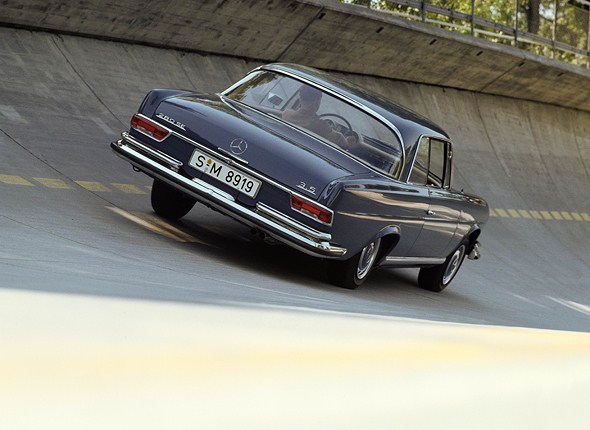
From SEC to CL: the C 140 series (1992 to 1998)
· Marked stylistic independence compared with related Saloons of the S-Class (140 series)
· Electronic Stability Programme ESPÒ makes debut in the Coupé
· Twelve-cylinder engine in the Mercedes-Benz 600 SEC/S 600 Coupé
The world premiere of the SEC Coupés from the C 140 series was staged at the North American International Auto Show in Detroit in January 1992; the European premiere followed two months later at the Geneva Motor Show.
The brochure of 1992 had this to say: “The new SEC Coupés are under the obligation of continuing a long-standing and successful tradition – a tradition of exclusiveness which is based on rarity and an out-of-the-ordinary character of form.
The Mercedes-Benz Coupés have been writing design history since the end of the 1920s.”
Initially two versions were offered: the 500 SEC with a V8 engine (235 kW) and the 600 SEC with a V12 engine (290 kW). Their engines and most of the engineering were identical with the corresponding Saloons from the 140 series.
Both were the top-of-the-range models from Mercedes-Benz – supplied with numerous extras ex factory. In stylistic terms, however, they were clearly more independent than their predecessors from the C 126 series.
“With the renunciation of everything superfluous, and with its clean, smooth lines, the S-Class Coupé proves that dynamism can do without ostentatious sportiness,” the brochure from the year 1993 said.
New model designations for all model series
Analogous to the other passenger car models from Mercedes-Benz, new model designations were introduced for the large Coupés in June 1993 as well, and the 600 SEC, for instance, was renamed S 600 Coupé.
From then on, the model plate on the trunk lid only revealed the displacement and the class of car, but no longer the type of bodywork – which was obvious anyway.
At the Geneva Motor Show in March 1994, two years after their European premiere, the Coupé family was extended by the addition of the S 420 Coupé which served as a more favourably priced entry-level model and, like its four-door counterpart from the Saloon series, was powered by a 4.2-litre four-valve V8 engine which developed 205 kW.
Two major technical innovations were available in the S 600 Coupé for the first time: in May 1995, a completely newly developed five-speed automatic transmission with slip-controlled torque converter lock-up clutch and electronic control was introduced which went a long way towards reducing fuel consumption.
Improvements were also achieved with respect to weight and dimensions in that the new automatic transmission was clearly lighter and more compact than comparable transmissions with five gear stages and could also be produced more economically as the number of individual components was reduced by almost 40 percent.
Another innovation of even greater significance was introduced at the same time: the Electronic Stability Program ESP® which supports the driver in the case of driving faults in that it counteracts instability through selective brake intervention, controlled by sensors, and thus contributes to safety.
From September 1995, the electronically controlled automatic transmission was also installed in the eight-cylinder Coupés; at the same time, the ESP® became optionally available for both models.
In June 1996, the model designations of the Coupés were changed again. The series was now called CL – and this was no end in itself but was to indicate that the large Coupés adopted a pacemaker function for the entire Coupé family.
At the same time, the CL Coupés also presented themselves in stylistically discreetly modified form: the externally distinguishing features were the revised bumpers with integrated sensors for the PARKTRONIC ultrasonic parking aid which was included in the standard specifications and replaced the previous guide rods on the rear fenders.
Other remarkable innovations were xenon headlamps with dynamic headlamp range adjustment, Tempomat cruise control operating down to 30 km/h, side airbags as standard and a seat occupancy recognition sensor for the front passenger’s seat.
Matured in this way, production of the CL models was discontinued in September 1998, almost precisely six years after the start of series production. Overall, 26,022 Coupés from the C 140 series had been built at the Sindelfingen plant.
The 140 series in the press
Auto, Motor und Sport, issue no. 3/1993, after a test comparing the Mercedes-Benz 600 SEC with the BMW 850 CSi and the Jaguar XJR-S:
“The Mercedes may not be the king of the road but is the uncontested master in terms of ride comfort. Optimum levels of noise suppression, seat comfort and climate control add up to a standard of comfort which is far above that of the two twelve-cylinder competitors.”
Frankfurter Allgemeine Zeitung, Germany, 16 March 1993, on the Mercedes-Benz 600 SEC:
“It is hard to imagine a quieter ride, even at high speed the wind merely whistles a quiet tune. Forceful acceleration is required if you want to hear the engine – and with such regal power at one’s disposal that occurs when most others have already given up.”
Road & Track, USA, April 1993, on the Mercedes-Benz 600 SEC:
“Fit for a king (and fetching a princely sum), this S-Class Coupé is just what someone like, say, Ludwig II would drive, were he alive today. You see, the 600 SEC is a Mad King kind of automobile, a mechanical metaphor for Ludwig’s castles, Neuschwanstein, Linderhof and Herrenchiemsee.
Now it would be a cheap shot to suggest that this Merc is as large as a palace, so let’s just say it’s as opulent, as distinctively styled, as inventively engineered and as comfortable as one of Ludwig’s edifices. And, unlike a castle, the 600 SEC is mobile – and fast.”
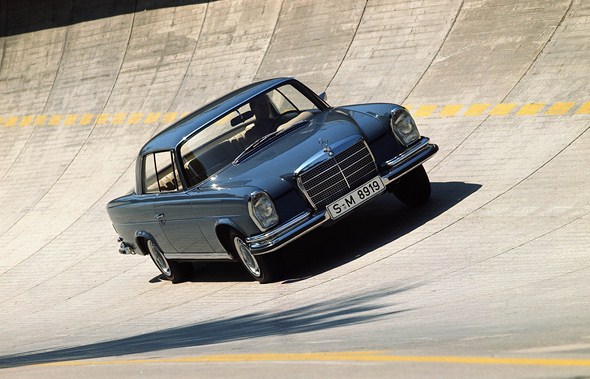
Large Coupé for the new millennium: the C 215 series (1999 to 2006)
· Large Coupé with four-eyed appearance
· World premiere of Active Body Control (ABC)
· Offer enriched by a range of AMG versions
At the Geneva Motor Show in March 1999, the Mercedes-Benz C 215 series – beginning with the CL 500 – celebrated its world premiere. Sales in Europe and Japan started in the fall of 1999. In early 2000, the CL 600 with twelve-cylinder engine joined the line-up.
“When you are back on the ground after a trip in the CL Coupé, it’s as if you were awakened from a beautiful dream. Make sure you find a fixed point of orientation – you’ll need it. Because you just returned from a different world. From the world of the CL Coupés.
” That’s how the CL brochure from 1999 summed up the essence of the large Coupés.
The C 215 series saw the world through four eyes. The brand’s typical, formally re-interpreted headlamp face, the elongated silhouette and the arched roof line enhanced the dynamism of the two-door model and gave it an out-of-the-ordinary and solitary character.
Extensive safety equipment
The standard equipment of the new large Coupés included, among other things, an extensive safety package with front and side airbags on the front seats, window bags, the Electronic Stability Program ESP®, acceleration skid control (ASR), anti-lock braking system (ABS), Brake Assist (BAS), novel bi-xenon headlamps with wash/wipe system and the PARKTRONIC system.
The top-of-the-range position of this Coupé was confirmed by equipment such as the multi-function steering wheel, adjustable steering column, five-speed automatic with one-touch gearshifting, TEMPOMAT cruise control with variable speed control SPEEDTRONIC, automatic climate control with activated charcoal filter, electrically adjustable leather-covered seats with memory function, Mercedes-Benz Audio 30 radio, leather trim on dashboard and doors and fine wood trim.
The list of options included an electronic tire pressure control system, the dynamic navigation system DynAPS, the chip-card-controlled Keyless-Go driver authorization system and active seat ventilation.
On the top model, the CL 600, the operating and control system COMAND, a car phone, a Bose sound system, upholstery covered with exclusive nappa leather and a roof lining made of soft Ultrasuede underlined the special class of this car.
At the time of its launch, the new large Mercedes-Benz Coupé featured a world first: the novel Active Body Control (ABC) suspension system which afforded an unprecedented optimum of sporty dynamism and comfort.
On the basis of sensor signals and using special hydraulic cylinders on the axles, ABC almost completely compensates for roll and pitch motions of the bodywork when starting off, cornering or braking.
“At the wheel of the CL, it’s like driving two different cars both at the same time: a sports car and a luxury limousine,” the CL brochure from 1999 summarized the system’s advantages.
Power and comfort in abundance: new twelve-cylinder engine
The powerful appearance of the CL was matched by the engines which were offered by Mercedes-Benz for the Coupé.
The top model, the CL 600, boasted a newly developed, smooth-running twelve-cylinder engine which generated 270 kW and a torque of 530 Newton metres.
Lightweight design, three-valve technology, double ignition with AC voltage ignition system and ionic-current diagnosis, automatic cylinder shut-off (which reduces fuel consumption under part-load), six catalytic converters and eight oxygen sensors – these are just a few examples of the sophisticated technical equipment of this ultra-modern unit.
The CL 500 was powered by a V8 engine with 225 kW and optionally available with automatic cylinder shut-off.
Exemplary aerodynamic efficiency (Cd value of 0.28), systematic lightweight design and a new dimensional concept were additional hallmarks of the Mercedes-Benz CL.
A modern hybrid concept, permitting the use of different lightweight materials such as aluminium, magnesium, steel and plastic, went a long way towards reducing the weight by up to 340 kilograms as compared to the predecessor.
A very special model was the CL 55 AMG F1 Limited Edition, available from the fall of 2000 in a limited edition of 55 units and fitted with decidedly exclusive appointments.
It carried a proud price tag of 330,000 Deutschmarks (approx. 168,500 euros), and it was modelled on the CL 55 AMG Safety Car used in Formula One.
The latter’s small-series counterpart was the world’s first road-going car with a particularly powerful brake system with internally ventilated brake discs made of fibre-reinforced ceramics.
These brakes stand out for a highly sensitive response, extreme thermal stability, continuous-load capability and a longer service life. In an emergency braking manoeuvre from top speed, a braking power of approx. 1475 kW is generated.
The CL 55 AMG “F1 Limited Edition” was powered by a 5.5-litre V8 engine with 265 kW. Among other things, the interior featured distinctively sporty front seats with optimized lateral support, an AMG sports steering wheel with perforated leather cover, carbon-fibre trim – and an “F1 Limited Edition” logo with consecutive numbering on the centre console.
The CL 63 AMG was the new top model of the series from the Frankfurt International Motor Show in 2001. The figure 63 reminded connoisseurs of the brand of the legendary Mercedes-Benz 300 SEL 6.3. The advanced engine of the CL 63 AMG developed 326 kW.
Exclusive world first: natural-stone trim

From the spring of 2001, buyers of the CL from the C 215 series were the first to be able to order natural-stone trim for the interior. In a special patented process, wafer-thin granite panels (0.6 – 0.8 millimetres thick) were produced before being specially formed and applied to centre console, interior door cladding, steering wheel rim and selector lever.
This exclusive trim was made available by the individualized designo program.
In 2002, the large Coupés were refined and given a modified front end with a modern clear-lens design and a revised front bumper.
The exterior-mirror housings were fitted with surround lighting which illuminates the ground next to the car and is switched on automatically when the doors are opened or when the central locking system is actuated by remote control. The rear end was equally discreetly revised.
V12 engine with biturbo charging
In 2002, biturbo charging was added to the V12 engine of the CL 600, and supporting measures were taken to boost output to 368 kW and the maximum torque to 800 Newton metres upwards of 1800/min at a charge pressure of one bar – amounting to 36 percent higher output and as much as 51 percent higher torque than on the previous twelve-cylinder unit.
The car accelerated from standstill to 100 km/h in 4.8 seconds; top speed was electronically limited to 250 km/h. Despite this impressive performance, the engine complied with the European EURO IV norm which did not come into force before 2005.
In the fall of 2002, a supercharged V8 engine with a displacement of 5.5 litres and developed by Mercedes-AMG set out to work in the CL 55 AMG. Like the twelve-cylinder unit, it developed 368 kW but was clearly sportier in its character.
A five-speed automatic transmission with gearshift on the steering wheel went a long way towards ensuring a dynamic motoring experience.
Apart from a certain amount of retouching, the CL 500 remained within the range without any modifications. The Active Body Control (ABC) was revised for all variants: in the updated version, the car’s total weight at any point in time was additionally recorded and included in the computations of the active suspension control system.
As a result, handling and ride became largely independent of the load.
Within the framework of model refinement, the safety package became even more sophisticated, among other things by the addition of so-called up-front sensors in the front end of the bodywork, which, in the event of a crash, recognize the severity of the impact at an early stage and trigger the front-passenger airbag in two stages, according to the situation.
What’s more, the belt tensioners are activated even earlier thanks to these sensors. Another new feature was the automatic two-stage classification of the front passenger’s weight by means of special sheeting in the seat upholstery.
As a result, the front-passenger airbag is triggered in two stages – in accordance not only with the accident severity but also with the occupant’s weight.
Performance was raised once again in 2003 – with the CL 65 AMG which generated 450 kW and made torque of 1000 Newton metres available at engine speeds between 2000/min and 4000/min.
All this sounds like the perfect car – and it is certainly true that the C 215 series came close to the ideal.
There is always room for improvement, however, as demonstrated by the completely newly developed C 216 series launched in June 2006. Of the C 215 series, 47,984 Coupés had been sold by 2006.
The 215 series as seen by the press
Auto, Motor und Sport, Germany, issue no. 23/1999, on the Mercedes-Benz CL 600:
“The special fascination of the CL 600 lies in the unique effortlessness of driving, and the new 5.8-litre V12 engine is a perfect match in this respect. The composure with which its 367 hp produce virtually every desired speed instantly but highly discreetly is awfully impressive, and, besides, also answers the question as to such an engine’s right to exist. The five-speed automatic, which interacts with the V12 in rarely encountered perfection, also deserves praise.”
Frankfurter Allgemeine Zeitung, Germany, 5 October 1999, on the Mercedes-Benz CL 600:
“The new CL, an impressive four-seater, is without doubt a highpoint in the brand’s design history – with its four-eyed front, bonnet remodelled around the headlamps, side lines rising steeply towards the rear and spoiler-like bootlid edge protruding over the triangular tail lights. It not only looks lighter and more dynamic than its predecessor, it really is.”
Road & Track, USA, November 2000, on the Mercedes-Benz CL 55 AMG:
“The CL 55’s progress proved effortless and serene, even at Autobahn pace (where one is obliged, after all, to keep to the fast lane and set a good AMG example.”
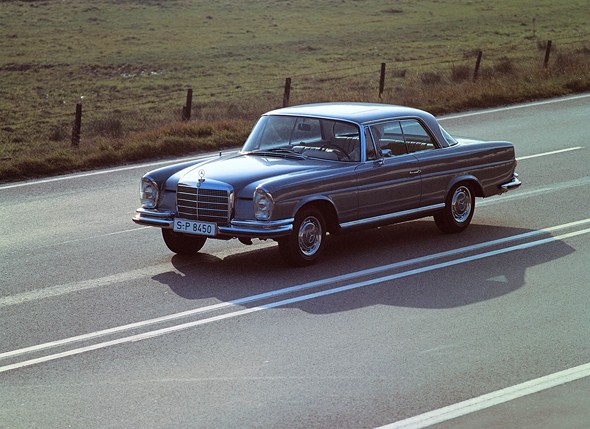
Redefining the Coupé standard: the C 216 series (from 2006)
· Taking driving safety into a new dimension with the PRE-SAFE® brake
· A control concept featuring fewer switches and more functions
In the fall of 2006 Mercedes-Benz brought the large Coupé of the C 216 series. The two-door model combined peerless exclusivity and charismatic design with the sort of cutting-edge technology that no other manufacturer worldwide can match.
The luxury Coupé raised the bar in terms of vehicle safety with the PRE-SAFE® brakes: the unique system automatically braked the Coupé before an imminent rear-end collision.
Furthermore, Mercedes-Benz innovations such as the Active Body Control (ABC) suspension system, the Intelligent Light System with five lighting functions and PRE-SAFE® anticipatory occupant protection all came as standard.
Two powerful engines with 8 or 12 cylinders were available, delivering a notable increase in output and torque. Thanks to their exemplary smoothness they also lived up to the Mercedes-Benz heritage of superb motoring refinement.
Compared with the outgoing model, the new Mercedes-Benz top-of-the-range Coupé grew only slightly in all dimensions.
5065 millimetres long, 1871 millimetres wide and 1418 millimetres high, the body was just 75 millimetres longer, 14 millimetres wider and 20 millimetres higher than before, providing even more comfort and space in all four seats.
The boot capacity was increased by 40 litres to 490 litres (VDA measuring method).
Launch with 8 and 12-cylinder powerplants
Equipped with the most powerful Mercedes-Benz engines available at the time of its launch, the new luxury Coupé was equal to any challenge whether on country road or motorway.

The eight-cylinder powerplant in the CL 500 delivered 285 kW and generated a maximum torque of 530 Newton metres from 2800 rpm. As such the newly developed engine outperformed the existing V8 unit by 26 percent in terms of output and 15 percent in terms of torque.

Equipped with four-valve technology, variably adjustable shifting camshafts, a two-stage intake module and tumble flaps in the intake ducts, the new V8 was among the most advanced, powerful engines in its displacement class.

The CL 500 accelerated from zero to 100 km/h in just 5.4 seconds (previous model: 6.3 seconds).

An ultra-modern biturbo twelve-cylinder engine under the bonnet of the new CL 600 generated its impressive power. Mercedes-Benz engineers enhanced numerous details of the power unit and, compared to the predecessor model, increased output by 12 kW to 380 kW.

The maximum torque, already on tap from 1900 rpm, was improved further by 30 Newton metres to 830 Newton metres and remained constant up to 3500 rpm. The new CL 600 accelerated from 0 to 100 km/h in just 4.6 seconds (previous model: 4.8 seconds).

Mercedes-Benz combined the standard-fit automatic transmission with the new DIRECT SELECT gearshift. This allowed the driver to select the transmission settings “P”, “N”, “R” and “D” by nudging a lever on the steering column. Operating commands were transmitted electronically by wire.

PRE-SAFE®: automatic partial braking before an impending accident
The C 216 series incorporated technical innovations as standard that featured in no other passenger car worldwide.

Mercedes-Benz was the world’s first car brand to develop an anticipatory occupant protection system that could recognise a potential accident situation in its early stages and take anticipatory occupant protection measures:
PRE-SAFE® was standard-fit in the C 216 series.
Mercedes-Benz complemented this multi-award-winning anticipatory protection system in the new Coupé for the first time with the newly developed PRE-SAFE® brake.
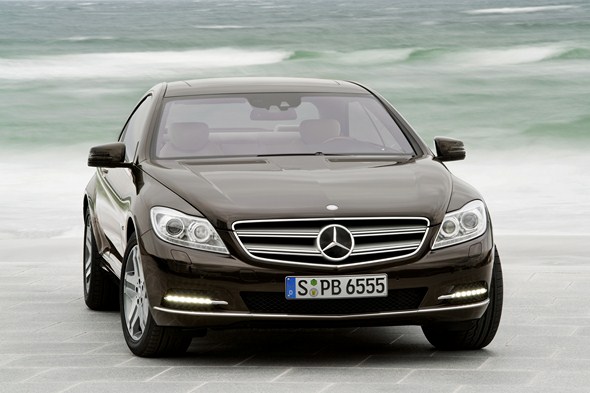
The PRE-SAFE® brake operated in tandem with Brake Assist PLUS (BAS PLUS), which warned the driver of an imminent rear-end collision with visual and audible signals and automatically calculated the required braking pressure to prevent an accident.

This braking-power support was available as soon as the brake pedal was operated. If the driver failed to react to the BAS PLUS warnings, the PRE-SAFE® brakes triggered automatic partial braking where an accident was imminent and slowed the CL-Class down using around 40 percent of the total braking power.

The automatic partial braking provided the driver with another clear warning to act. If the driver then immediately applied the brakes, the maximum braking force was available and – depending on the situation – the accident could be averted at the last moment. If an accident was unavoidable, the PRE-SAFE® brakes reduced the impact severity and, in turn, the risk of injury to the vehicle occupants.

Active Body Control and Intelligent Light System
An even more sophisticated version of the Active Body Control ABC suspension system was used in the C 216 series, giving the Coupé unprecedented handling dynamics while offering an equally appreciable improvement in ride comfort.

The Intelligent Light System made driving even safer in the dark. Together with bi-xenon headlamps it formed part of the standard specification for the new CL-Class and provided five different lighting functions that were activated to match driving and weather conditions: the new country road mode illuminated the driver’s-side edge of the road more widely and brightly than the existing low-beam headlamps.

Motorway mode, which came on automatically when driving above 90 km/h, delivered a uniform cone of light that illuminated the entire road width. In the centre of this cone the driver was able to see around 50 metres further.

The enhanced fog lamps were also new, which Mercedes-Benz used to provide better orientation in adverse weather conditions. Active light function and cornering light function were also part of the standard-fit Intelligent Light System on the CL-Class.

Large Coupé synonymous with style
The CL Coupé established the mould for a new Mercedes-Benz style. Its hallmark was the interaction between distinctive tightly drawn lines with large, unruffled surfaces.

This design idiom lent the Coupé its own particular expressive power, emphasising the calm and inner strength of its athletic, self-confident nature. Familiar Mercedes-Benz features were given a contemporary twist, resulting in a harmonious blend of the classic and contemporary.

Examples included the hallmark Mercedes-Benz radiator grille with its wide chrome louvres and the design of the C-pillar. The unique, slightly downwards-tapering pillar configuration was a typical feature of the large Mercedes-Benz Coupés.

The interior was also designed for stylish comfort and relaxation. Five colour combinations were available; automatic climate control, COMAND with car radio and CD/DVD player as well as a glass sunroof were all part of the standard specification, elements that came together to deliver a unique motoring and comfort experience.

In the top-of-the-line CL 600 the Exclusive PASSION leather appointments, specially selected poplar wood and an Alcantara roof liner with quilted seams provided the finishing touches to an exquisite first-class ambience, a look and feel also echoed in the seats with their designo styling, the chromed door sill panels and floor mats with leather edging.

The standard specification also included dynamic multicontour seats with massage function and seat ventilation, the hard-disc navigation system COMAND APS, the LOGIC7® surround sound system with DVD changer and the KEYLESS-GO access and drive authorisation system.

Control system: fewer switches and more functions
A newly developed control system, which had already been successfully implemented in the S-Class worldwide, refined driver-vehicle interaction even further.

Above all, it provided convenient, rapid access to frequently used functions such as car radio, DVD player, car phone or navigation system. The standard-fit automatic climate control with four independently adjustable temperature zones was also integrated into the new control system.

The driver and front passenger could select temperature, air distribution and other settings either using the COMAND controller and menu-based control, or by means of an attractively styled switch array beneath the air vents.
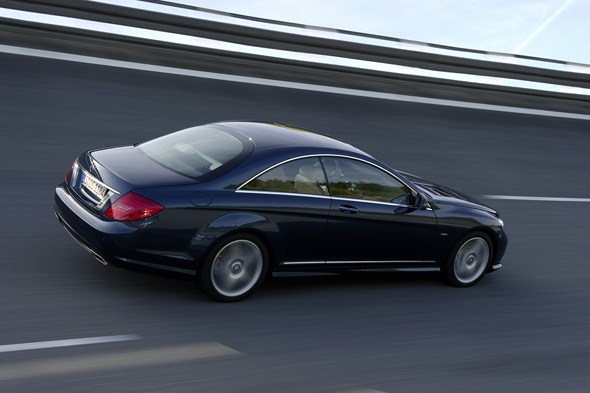
The newly developed integral seats in the CL-Class provide maximum individual seating comfort. “Integral” means that all components of the seat-belt system are incorporated directly into the seat; hence the seats form an important component in the occupant protection system.
Optional extras include luxury seats with active ventilation (standard in the CL 600) that provide even more individual comfort, along with the further enhanced multicontour seats with nine air cushions, and dynamic multicontour seats with massage function (standard in the CL 600).
Flagship models from AMG for the C 216 series
At the 2006 Paris Motor Show Mercedes-Benz presented the CL 63 AMG with 6.3-litre V8 engine as its flagship model in the C 216 series. It was joined the following year at the 2007 New York International Auto Show by the CL 65 AMG with V12 engine.
The heart of both top-of-the-line eight-cylinder models was the 100% AMG-developed AMG 6.3-litre V8-engine. From a displacement of 6208 cc, this high-revving, naturally aspirated engine delivered an output of 386 kW at 6800 rpm and a maximum torque of 630 Nm at 5200 rpm.
This gave the AMG powerpack a higher specific output and specific torque than any other series-produced naturally aspirated eight-cylinder engine in the world. The CL 63 AMG accelerated from a standing start to 100 km/h in 4.6 seconds, and its maximum speed was electronically limited to 250 km/h.
The CL 63 AMG gave the impression of high-performance athlete in a bespoke suit. Equipment included the muscular AMG bumper with round fog lamps set in chrome rings, large air intakes and side vents.

Whereas the Coupé shared these details with the S 63 AMG Saloon, only the CL 63 AMG featured chrome surrounds around the air vents and the striking AMG radiator grille with two horizontal chrome louvres and numerous vertical slats in black.

Visual and acoustic highlights were provided by the two chrome twin tailpipes of the AMG sports exhaust system. Another distinguishing feature was the “6.3 AMG“ lettering on the front wings.

This sporty and exclusive styling was continued in the interior. The extensive standard appointments included PASSION leather upholstery and multicontour AMG sports seats with their own cross-piping design and massage function.

The AMG instrument cluster displayed the AMG main menu with the “RACETIMER“. Another eye-catching feature in the interior was the exclusive analogue clock modelled on the design of the “IWC-Ingenieur“ series in the centre console. The overall picture was rounded off by AMG entry sills of brushed stainless steel.
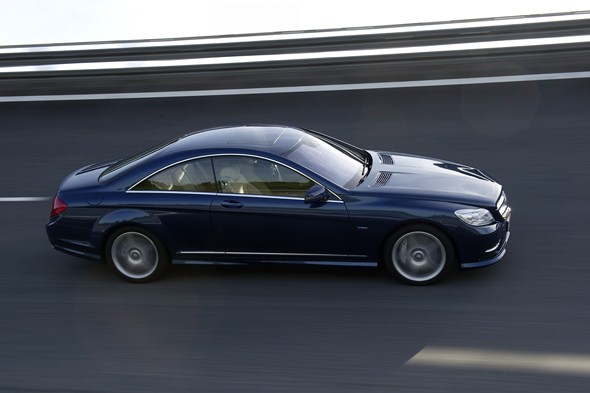
Another equally exclusive dream car joined the AMG model range in 2007 in the form of the new CL 65 AMG. This high-performance Coupé was powered by the AMG 6.0-litre V12 biturbo engine.

Thanks to a maximum output of 450 kW and maximum torque of 1000 Newton metres it delivered a truly impressive driving experience, accelerating from 0 to 100 km/h in 4.4 seconds and reaching the 200-km/h mark in 13.3 seconds. Its maximum speed was 250 km/h (electronically limited).

Standard features included AMG bodystyling, 50.8-centimetre AMG forged wheels, the unique AMG interior and highly advanced technology, such as AMG sports suspension, based on the Active Body Control system, and the anticipatory occupant protection system PRE-SAFE®.

The AMG high-performance brake system with new double-frame sliding callipers offered maximum deceleration without fading.

“40th Anniversary” edition with AMG Alubeam paint finish
In order to mark the 40th anniversary of Mercedes-AMG – the high-performance brand of the Mercedes Car Group – in suitably glittering style, the CL 65 AMG was also offered as a “40th Anniversary” limited-edition model.
A new type of paint finish reflected the special status of this exclusive version, which was restricted to just 40 vehicles for the whole world.
This exceptional AMG Coupé was the very first series-production Mercedes to feature AMG Alubeam, a unique paint finish previously only seen on a handful of Mercedes-Benz show cars.

A world first, this new process causes the paint to gleam like liquid metal. The paint, which seemed to be stretched over the vehicle’s body like a metallic skin, emphasised the compelling lines of the large Mercedes-Benz Coupé more effectively than any other paint finish, while the light played on these in a way calculated to produce an even more vivid look.
This was made possible by the use of pigment particles measuring just 30 to 50 nanometres in size and which were therefore incorporated into the surface of the paint even more evenly. As a result, the light was reflected much more intensely and the lustre of the paintwork enhanced.
To put this into perspective, conventional paintwork pigments measure between 100 and 300 nanometres in size.
The superbly styled interior also made an impressive statement: the CL 65 AMG “40th Anniversary” featured two-tone EXCLUSIVE PASSION all-nappa-leather upholstery with the new AMG V12 diamond pattern, a colour-coordinated Alcantara roof lining and embossed V12 logos on the front head restraints.
Coupé with all-wheel drive
From summer 2008, Mercedes-Benz also offered all-wheel drive for its luxury CL-Class Coupé for the first time. The new CL 500 4MATIC provided even greater traction and handling stability in the wet, in snow or on ice.
In this vehicle Mercedes-Benz used the latest-generation system that had already proved successful in the S-Class. 4MATIC was permanently active and therefore required no response time to come to the driver’s aid in unfavourable weather and driving conditions.
As a result, critical situations could be mastered more effectively and confidently. The heart of the all-wheel-drive system was a transfer case with a central differential, which was integrated into the seven-speed automatic transmission. From here, the drive torque was split between the front and rear axle at a ratio of 45 to 55.
Another new feature was the twin-plate clutch at the central differential. This produced a basic locking effect of around 50 Newton metres between the front and rear axle, which allowed variable torque shift between the axles as the situation dictated.
The new 4MATIC model in the CL-Class range was characterised by the same high-quality safety and comfort features as the luxury Coupé with rear-wheel drive, and additionally offered PASSION leather appointments, a ski bag, multicontour front seats and 45.7 centimetre nine-spoke light-alloy wheels.
Other Mercedes-Benz innovations available as an option included the radar-based Brake Assist PLUS, PRE-SAFE® brakes and night view assist
Anniversary model honours the trademark
In 2009 Mercedes-Benz celebrated the one hundredth birthday of the Mercedes star and the Benz emblem with a particularly exclusive edition of the CL Coupé.
The exquisite equipment details included beautifully executed emblems of the original trademarks inset into the centre console. These were accurate reproductions of the emblems that Daimler-Motoren-Gesellschaft and Benz & Cie.
registered as trademarks one hundred years ago, forming the basis for the Mercedes star. With its exclusive equipment, the special “Trademark Centenary” edition underlined the special position held by large Coupés from Mercedes-Benz.
The C 216 series is to undergo a major model refinement for the model year 2011. The Coupés will be refined at the highest level, bringing further perfection but also innovative technology.

The C 216 series in the press
Frankfurter Allgemeine Sonntagszeitung, Germany, 3 September 2006,on the Mercedes-Benz Coupés of the C 216 series: “In a Mercedes Coupé it becomes obvious that Saloons are redundant.
Rear seats are only there in case someone unexpectedly needs a lift – an event any Coupé driver would rather not think about. For the Coupé driver appreciates the serenity of automotive mobility and desires to stand out among the crowd of everyday vehicles.
His Coupé is a ‘Sunday-best’ car for every day of the week.”
Autorevue, Austria, issue 12/2006, on the Mercedes-Benz CL 500:
“In the CL sensibilities takes priority over actions. One drives, one hears the engine – but nothing more than an atmospherically enlivening fundamental, a note that changes key depending on the angle of the accelerator pedal.
One is not even affected any longer by noise from the world outside. One is embedded in a control loop that creates an overall situation from the tiniest of movements.
The manner, speed and force with which one steers, brakes or accelerates set in motion actions initiated or reinforced by the system that keep the car on track, retard it powerfully or keep it horizontal on cornering.
A part of this is the driver’s will. But in extremis, the car take from one’s own input only what it considers reasonable. And the first unexpected encounter with wet autumn leaves or early snow reminds one what an excellent idea this is.”
Road & Track, USA, August 2007, on the Mercedes-Benz CL 600:
“Out on the open road, the CL 600 stretches its legs and covers ground in a comfortable flash. Ride quality is excellent, no matter the surface, and the handling is quite impressive for a large, substantial coupe.
Winding country roads with little or no traffic are the ideal setting for this car, as you can exercise the V-12 with complete confidence in the Mercedes multilink suspension with Active Body Control, 4-wheel disc brakes with ASS and lots of other technology to keep you on an even keel.”
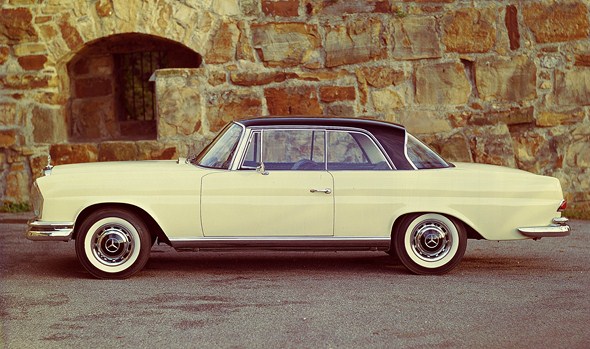
Production figures for the Mercedes-Benz W 188 series (1952 to 1958)
Model Internal designation Production period Preproduction to end Number of units
300 S Coupé W 188 I 1951 – 1955 216
300 Sc Coupé W 188 II 1955 – 1958 98
Total 314
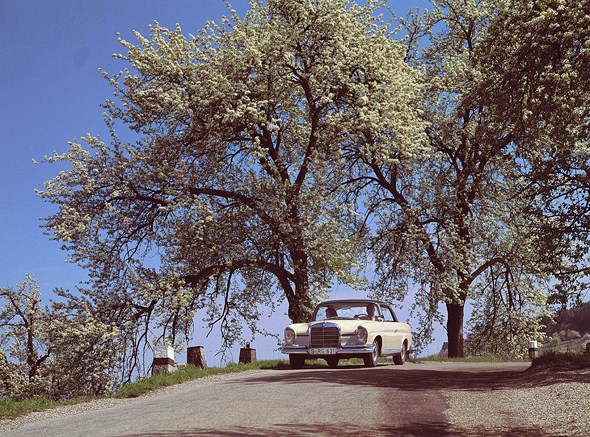
Production figures for the Mercedes-Benz W 187 series (1953 to 1955)
Model Internal designation Production period Preproduction to end Number of units
220 Coupé W 187 1953 – 1955 85
Total 85
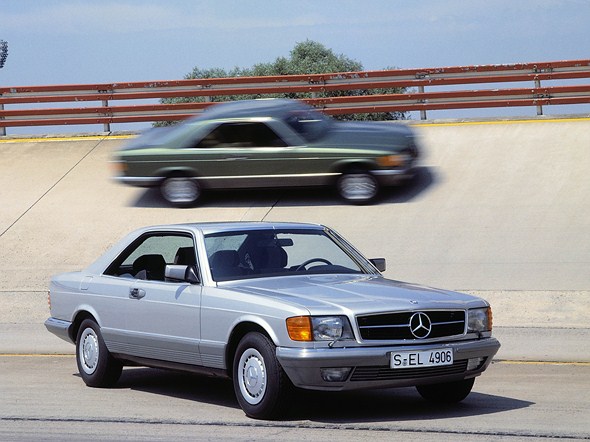
Production figures for the Mercedes-Benz W 180/W 128 series (1956 to 1960)
Model Internal designation Production period Preproduction to end Number of units
220 S Coupé W 180 II 1956 – 1959 1251
220 SE Coupé W 128 1958 – 1960 830
Total 2081
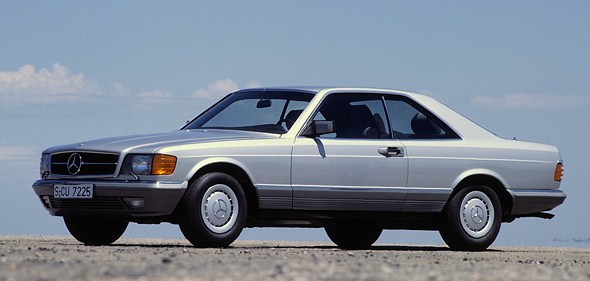
Production figures for the Mercedes-Benz W 111/W 112 series (1961 to 1971)
Model Internal designation Production period
Preproduction to end Number of units
220 SEb Coupé W 111/3 1960 – 1965 14,173
250 SE Coupé W 111/III A 1965 – 1967 5259
300 SE Coupé W 112/3 1962 – 1967 2419
280 SE Coupé W 111 E 28 1967 – 1971 3797
280 SE 3.5 Coupé W 111 E 35/1 1969 – 1971 3270
Total 28,918
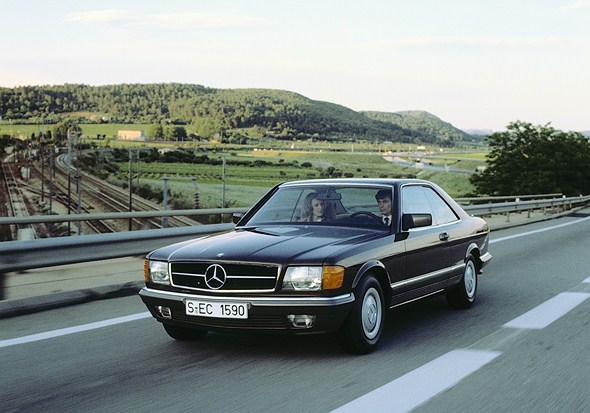
Production figures for the Mercedes-Benz C 107 series (1971 to 1981)
Model Internal designation Production period
Preproduction to end Number of units
280 SLC C 107 E 28 1974 – 1981 10,666
350 SLC C 107 E 35 1971 – 1980 13,925
380 SLC C 107 E 38 1980 – 1981 3789
450 SLC* C 107 E 45 1972 – 1980 31,739
450 SLC 5.0 C 107 E 50 1977 – 1980 2769
500 SLC C 107 E 50 1980 – 1981 **
Total 62,888
* Prior to March 1973 only for export to North America
** Number of units included under 450 SLC 5.0
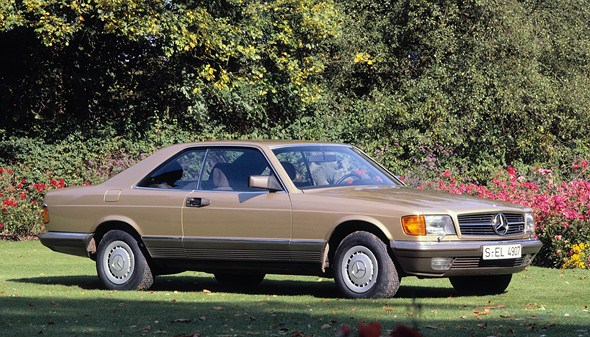
Production figures for the Mercedes-Benz C 126 series (1981 to 1991)
Model Internal designation Production period
Preproduction to end Number of units
380 SEC C 126 E 38 1980 – 1985 11,267
500 SEC C 126 E 50 1980 – 1991 30,184
420 SEC C 126 E 42 1985 – 1991 3680
560 SEC C 126 E 56 1985 – 1991 28,929
560 SEC (ECE-Version) C 126 E 56 1985 – 1987 *
Total 74,060
* not documented separately
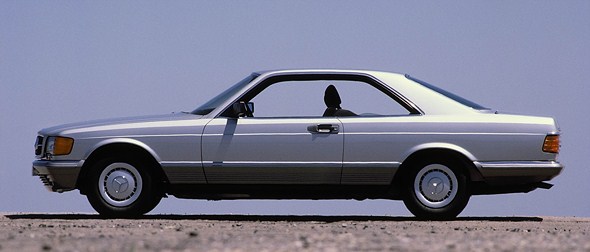
Production figures for the Mercedes-Benz C 140 series (1992 to 1998)
Model Internal designation Production period
Preproduction to end Number of units
500 SEC / S 500 Coupé / CL 500 C 140 E 50 1992 – 1998 14,953
600 SEC / S 600 Coupé / CL 600 C 140 E 60 1992 – 1998 8573
S 420 Coupé / CL 420 C 140 E 42 1994 – 1998 2496
Total 26,022
